Dear creative friends,
Welcome to Issue NO. 62 of the Studioworks Journal! In this edition, we embark on a captivating expedition into the heart of the Romantic movement, a period that championed the beauty of nature and the profound depths of human emotion. Romanticism, with its emphasis on awe, wonder, and the majesty of the natural world, offers us a unique lens through which to view our artistic endeavors.
As we delve into this theme, I invite you to immerse yourself in the essence of the sublime. Let us explore how the Romantics sought to capture the overwhelming power and grandeur of nature, and how they expressed the vast spectrum of human emotion through their art. This month, our focus is not just on appreciating the Romantic movement, but on embodying its principles in our own creative expressions.
How can we, as modern creators, harness the spirit of Romanticism in our work? How do we evoke the sense of awe and reverence for the natural world that is so central to this movement?
Let us be inspired by beauty that surrounds us.
xo,

So you may be wondering, where do I start? To that, I say, wherever feels right to you. Each month we will have a theme, a creative affirmation, a power word, a color palette, sketchbook exercises, art projects, articles, recommended reading, and access to wonderful inspiration and resources. I want you to think of this as a delicious new magazine, you know the ones you occasionally splurge on, with soft, velvety pages, beautiful images, and inspiring content!
Each issue will invite you to explore your creative practice in whichever way works for you. Experience each issue at your own pace. Take what resonates with you and put the rest aside for another time.
Grab a cup of something lovely and dive in.
I'm thrilled to dive into our exploration of the Romantic period, a truly fascinating era in art and literature that still resonates with us as artists today. The Romantic period, flourishing from the late 18th to the mid-19th century, was a time of immense social, political, and industrial change. But what makes it really stand out, and why I believe it's so crucial for us to study, is its profound emphasis on emotion, nature, and individual expression.
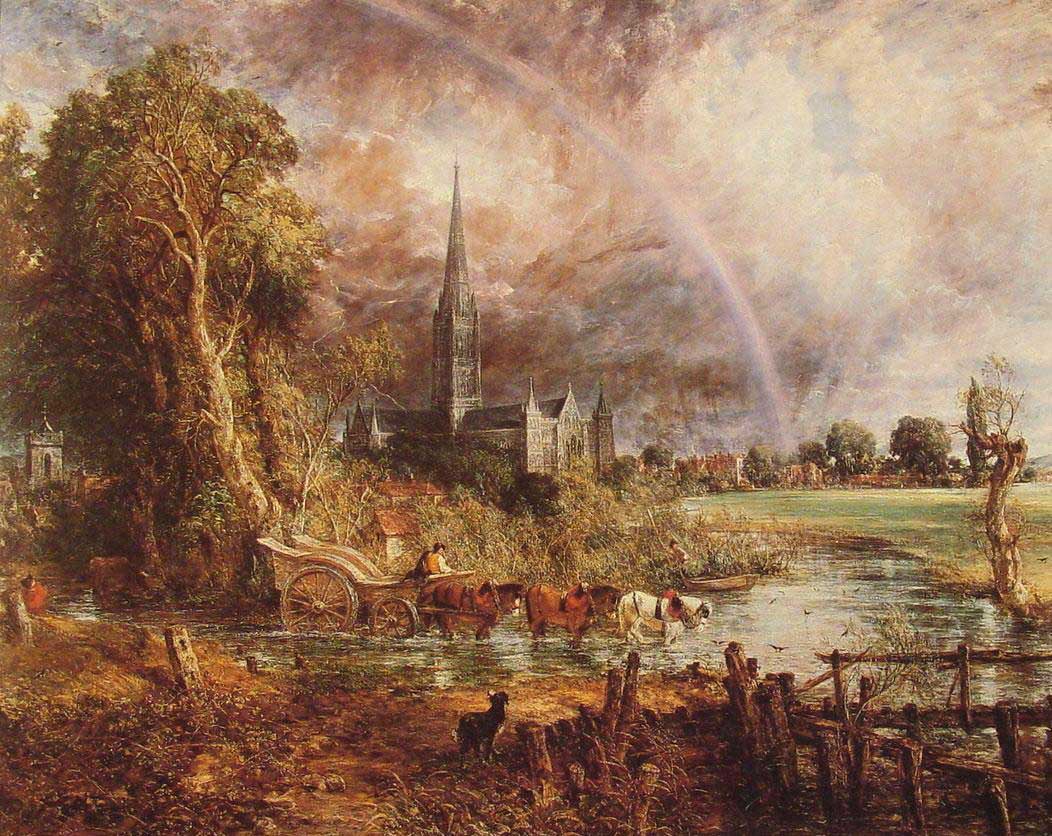
The Fighting Temeraire
J.M.W. Turner, 1838
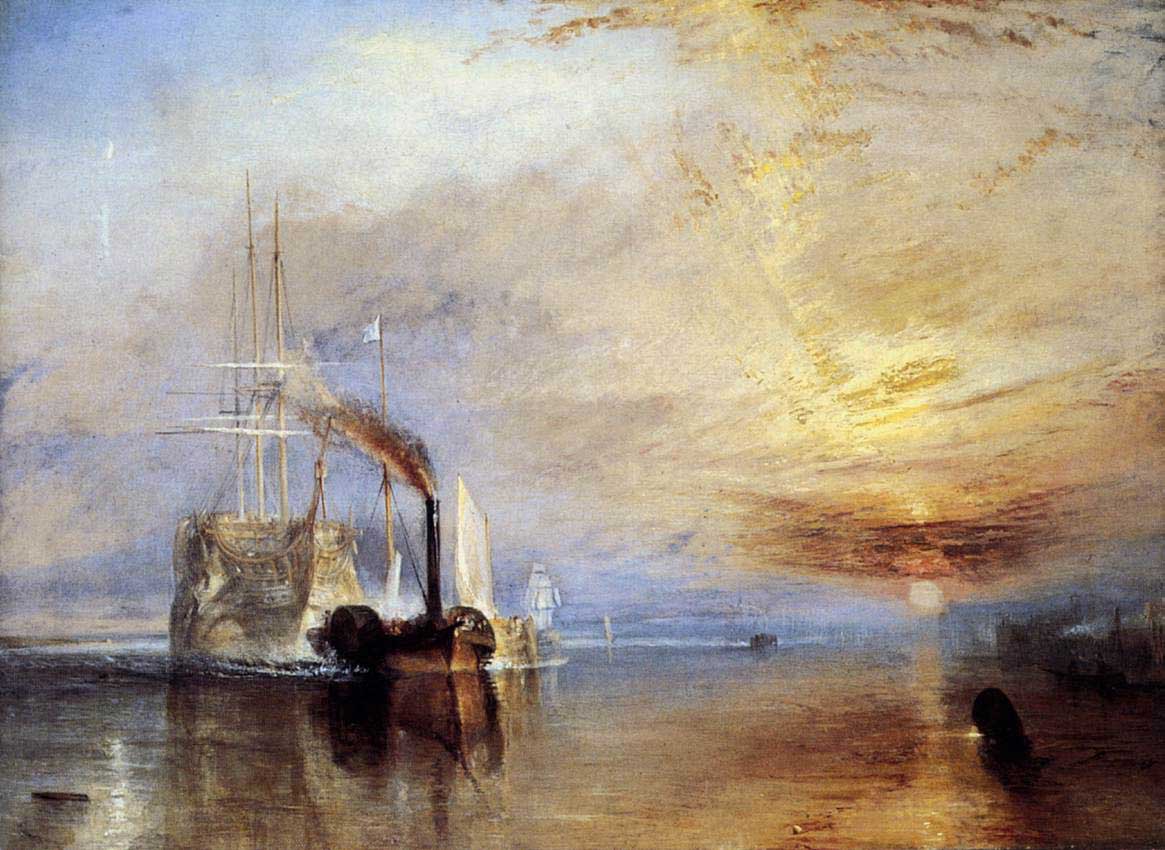
The Monk by the Sea
David Friedrich, 1808
What's really exciting for us as contemporary artists is seeing how the themes from the Romantic era – like the awe of nature, the exploration of the self, and the celebration of imagination – are still so relevant. They remind us of the power of our individual voices and perspectives. In a way, studying the Romantic period is like uncovering the roots of our own artistic expressions.
So, as we journey through this era, let's keep our minds open to the inspiration it offers. Let's see how we can incorporate the intensity, the passion, and the reverence for the natural world that characterized Romantic art into our own work. I'm looking forward to seeing how this exploration sparks new ideas and perspectives in each of us
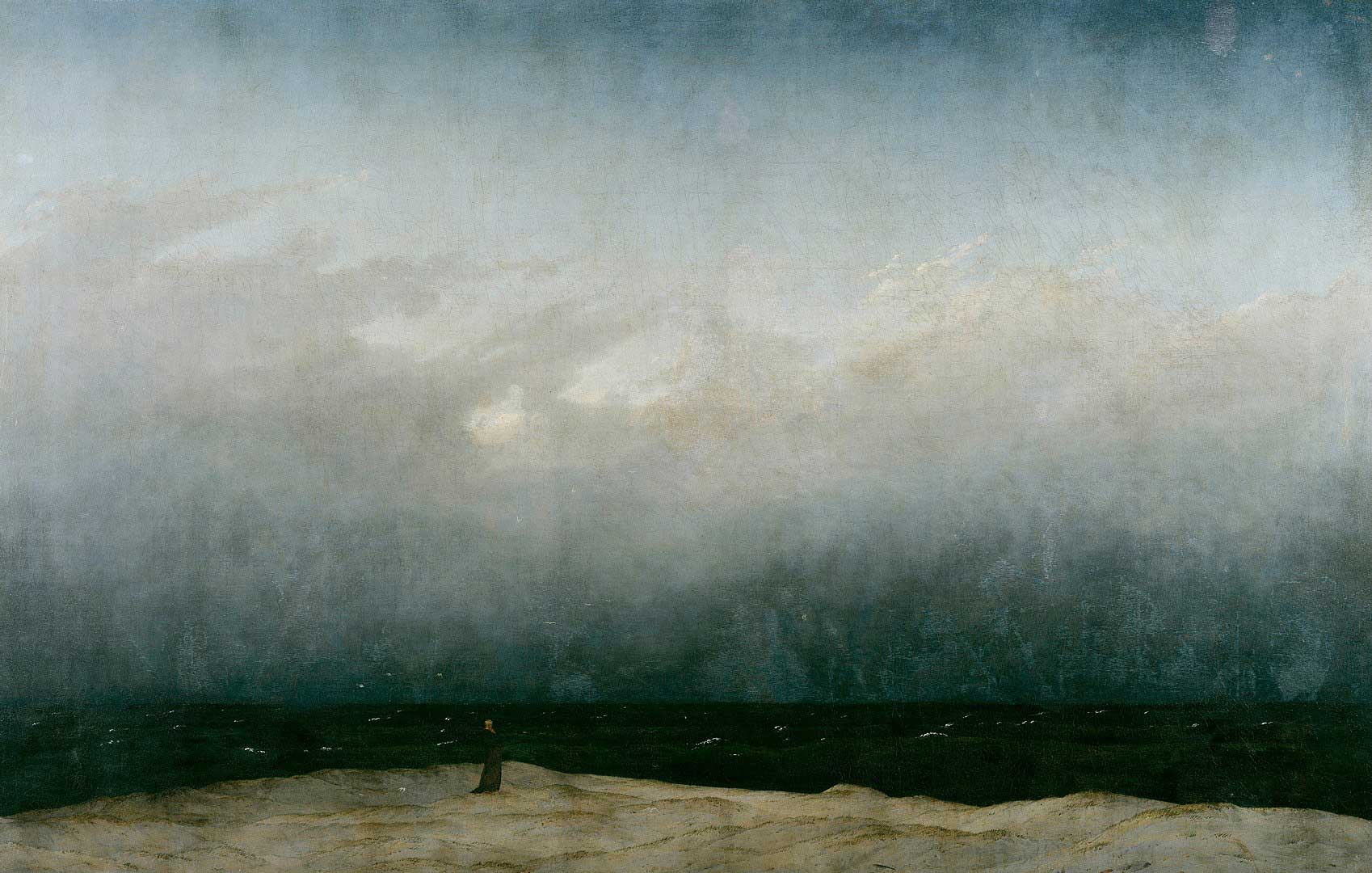
The Monk by the Sea
Casper David Friedrich, 1808
Imagination is vital for creating art; it is also crucial for perceiving our world and conceptualizing our place within it. Myriad lenses, such as our mood, background, and culture, will influence anything we observe. Understanding this, we can choose to imagine deliberately, actively shaping our desired view.
For example, to bring richness to our vision, we can tap into our emotions and choose to employ a romantic lens. This process will add a dimension to our art that transcends the confines of subject matter, tapping into a deeper facet of the human experience. This romantic view is bound to unleash our creativity in powerfully evocative ways. Let’s learn from masters of the Romantic era, exploring how they connected with themselves, their societies, and the natural world to manifest enduringly impactful art.
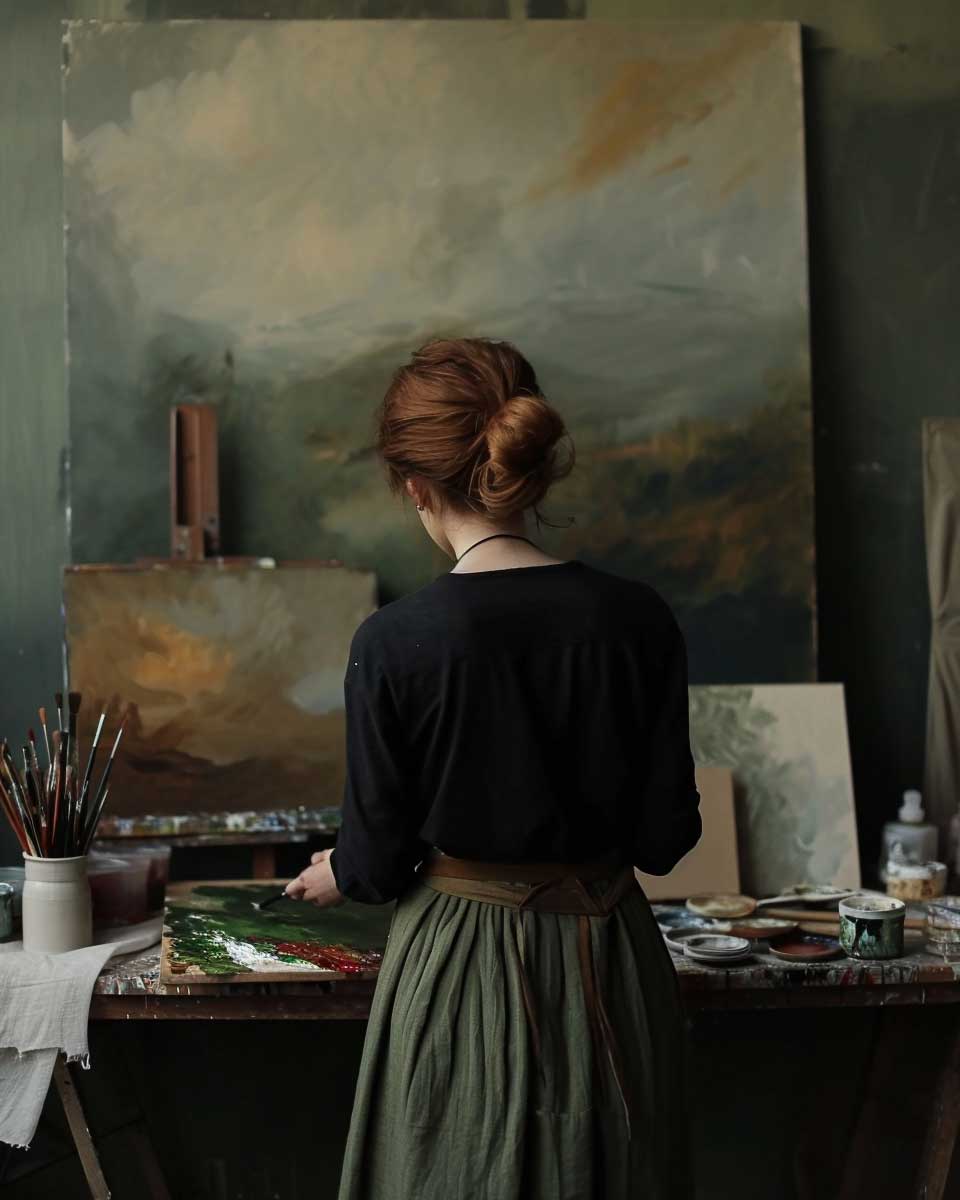
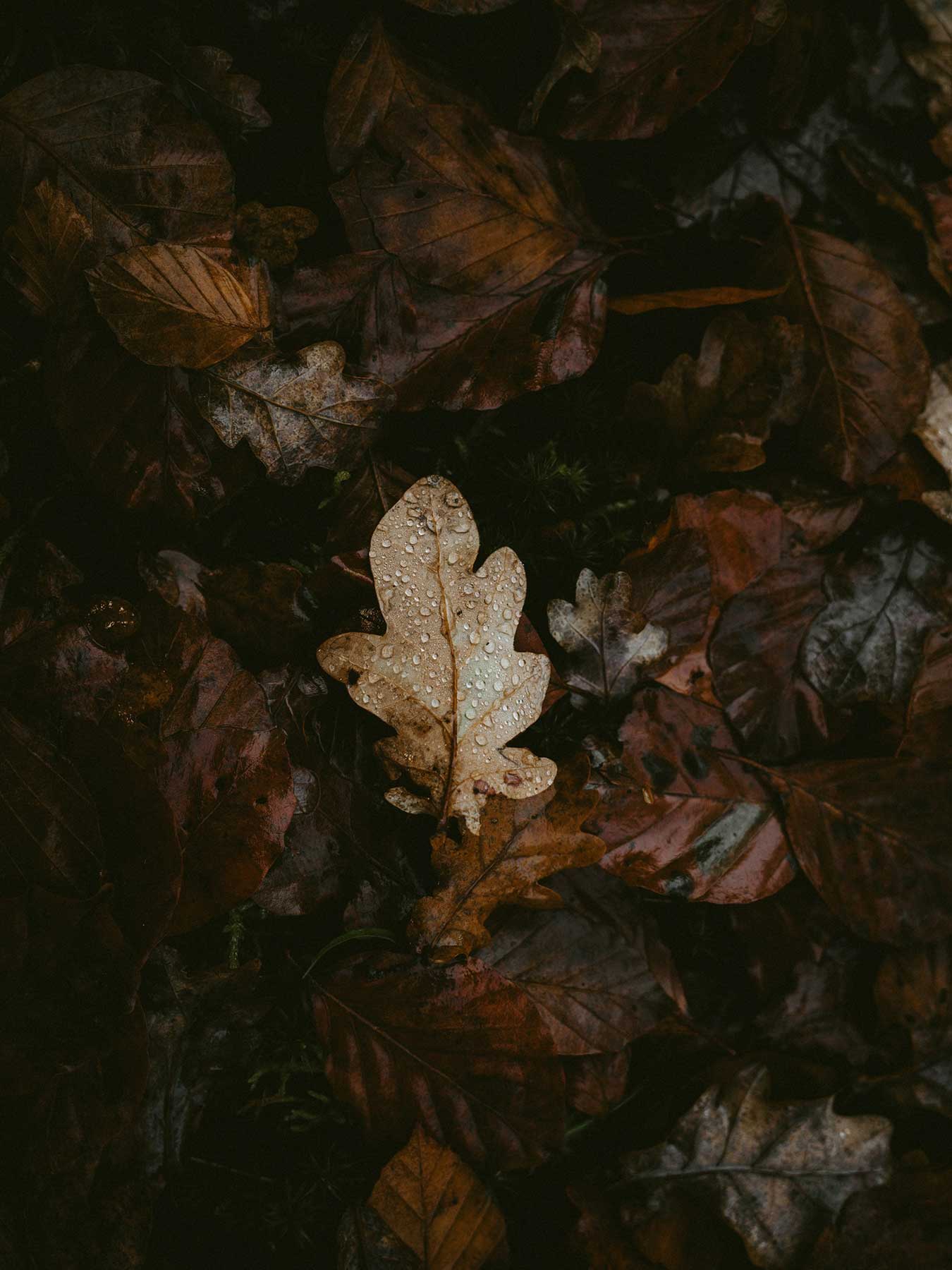
To be a romantic is to have a love affair with life, seeing everything through the eyes of adulation and wonder. The simple act of looking for beauty brings it surging to the foreground. Dewdrops become gemstones, clouds exotic shapeshifters, and the moon a luminous love light.
However, this keen appreciation can turn to suffering, and not all close observation yields pretty emotions. There is room for wild, uncontrollable, unpredictable, and even cataclysmic forces to emerge when the depths of feelings are plumbed. Regardless, committing to this process yields a potent view of all that occurs, from disasters to exaltations, increasing the poignancy of anything created from this perspective.
The masters of Romanticism understood this, and though the movement reigned supreme from 1780 to 1850, their influence thoroughly shaped the art world throughout the 19th century. The Romantics brought a hearty dose of individualism, emotion, appreciation of nature, and a touch of the political to the art of this period. The movement impacted every corner of the creative world, giving rise to the likes of Beethoven and Chopin, Blake and Shelley. Still, it was the artists and sculptors that truly defined the era for generations to come.
The reasons for their enduring popularity were manifold, from sloughing off the mantle of rationalism imposed by Neoclassicism and diving headlong into personal feelings to deeply examining and articulating metaphors of the human spirit. The Romantics knew how to stir up deep feelings and tap into essential life experiences; this evidently has staying power.
The early influencers of the Romantic era were trained in quintessentially neoclassical style, yet they managed to imbue their work with highly personal angles, a fundamental tenet of Romanticism. Two brilliant examples of this fusion of styles are Jean Auguste Dominique Ingres’ La Grande Odalisque and Eugène Delacroix’s Death of Sardanapalus.
Another strong drive in the romantic movement was to counter industrialization's ugliness and emphasize nature's beauty. In this vein, en plein aire paintings were a valued part of the era. John Constable was an artist who excelled in creating quintessential landscapes of the period. His piece, The Hay Wain, perfectly encapsulates a sense of oneness with nature and his belief that “painting is but another word for feeling."
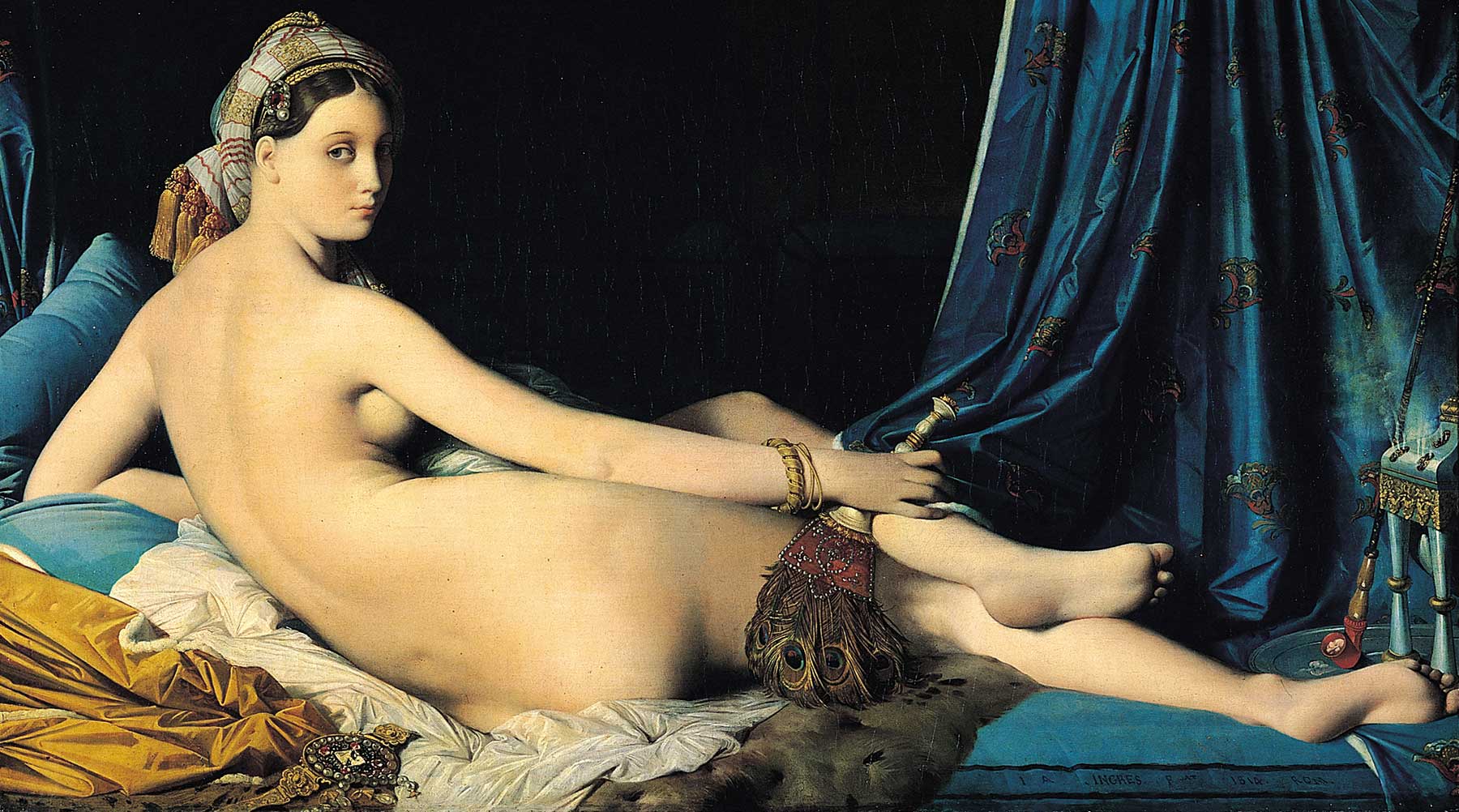
La Grande Odalisque
Jean Auguste Dominique Ingres, 1814
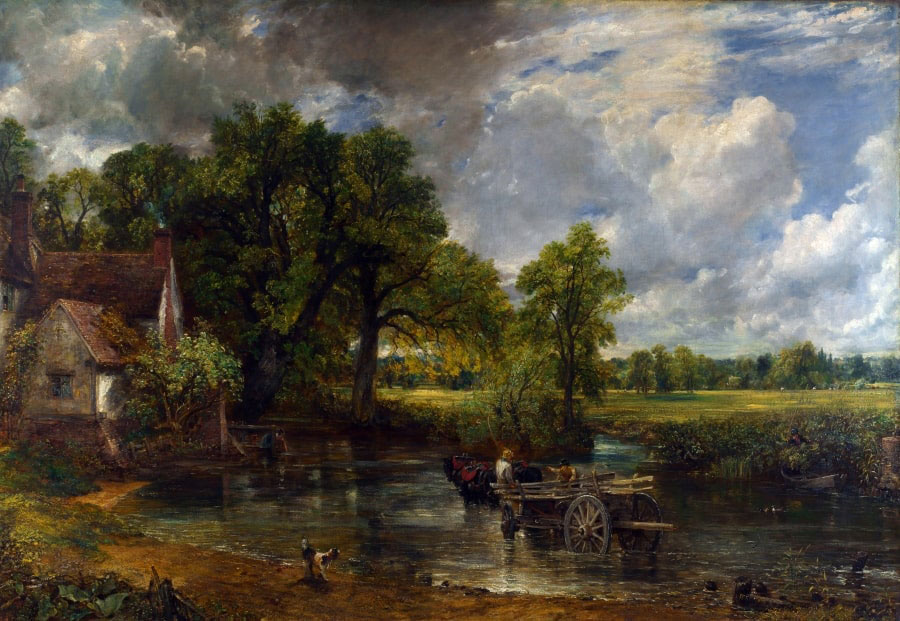
The Hay Wain
John Constable, 1821
Despite the beauty of Romanticism, there was also a heavy dose of activism that led to the portrayal of major social issues. Embracing this urge to say something meaningful and yet create a vividly lustrous and impactful image was the piece The Slave Ship by J. W. Turner.
In this painting, he depicts humans as insignificant while demonstrating his abolitionist spirit by condemning slavery, showing everyone equalized and overwhelmed by nature’s grandeur and immensity.
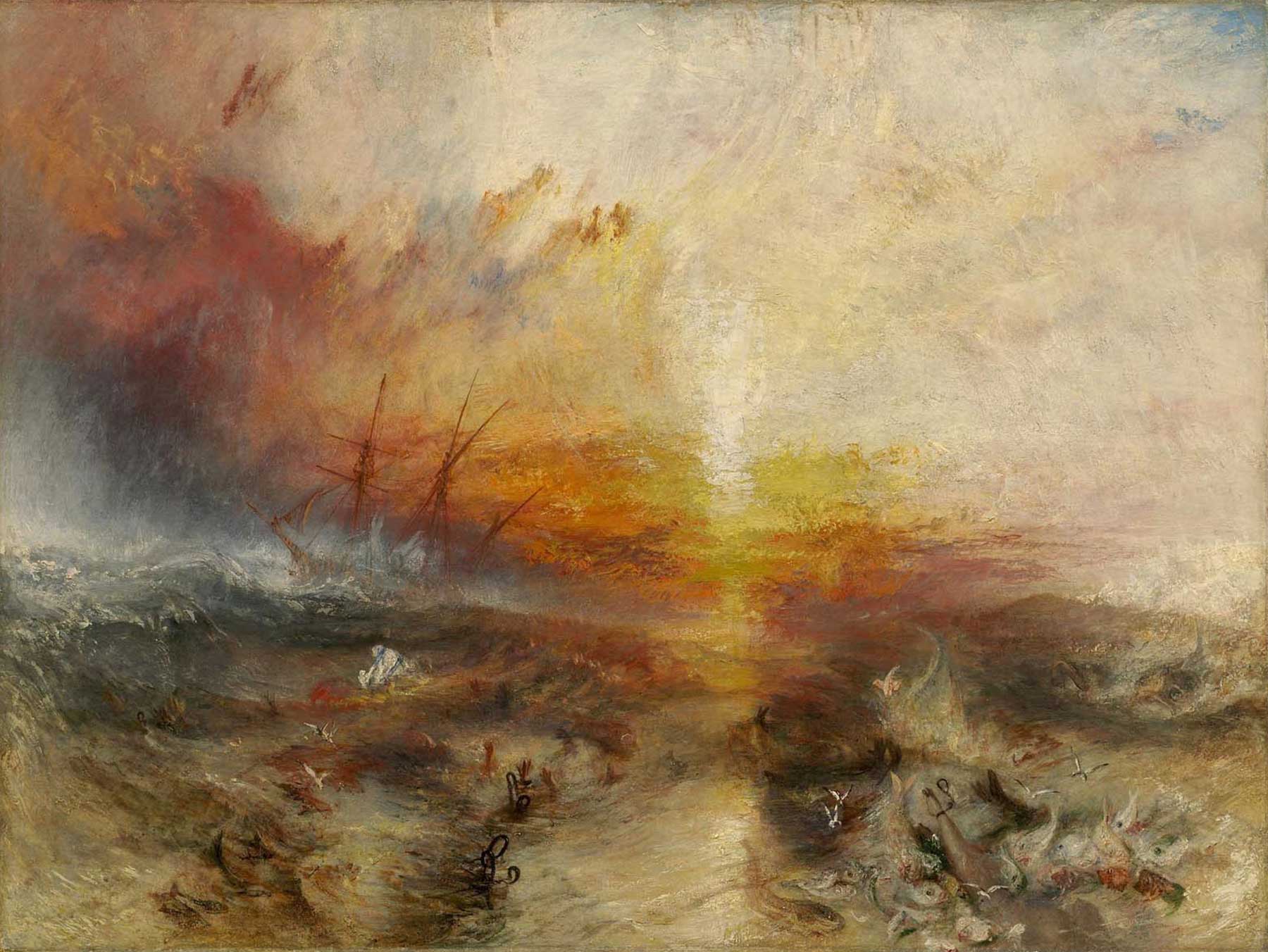
The Slave Ship
J.M.W. Turner, 1840
The romantic spirit invites us to embrace our emotions in their full capacity. In so doing, we can explore the dynamics between ourselves, our communities, and the natural world through a highly personal and stylized lens without shying away from intensity. If what we feel is connected, that will reveal itself. If, on the contrary, we experience repulsion, that too will be known.
It’s freeing to incorporate ourselves into our work, allowing the emerging emotions to express themselves as they deem fit. When our art is this personal, it can’t help but unleash uniquely impactful creations. So, dig deep, let loose, and set your romantic feelings free.
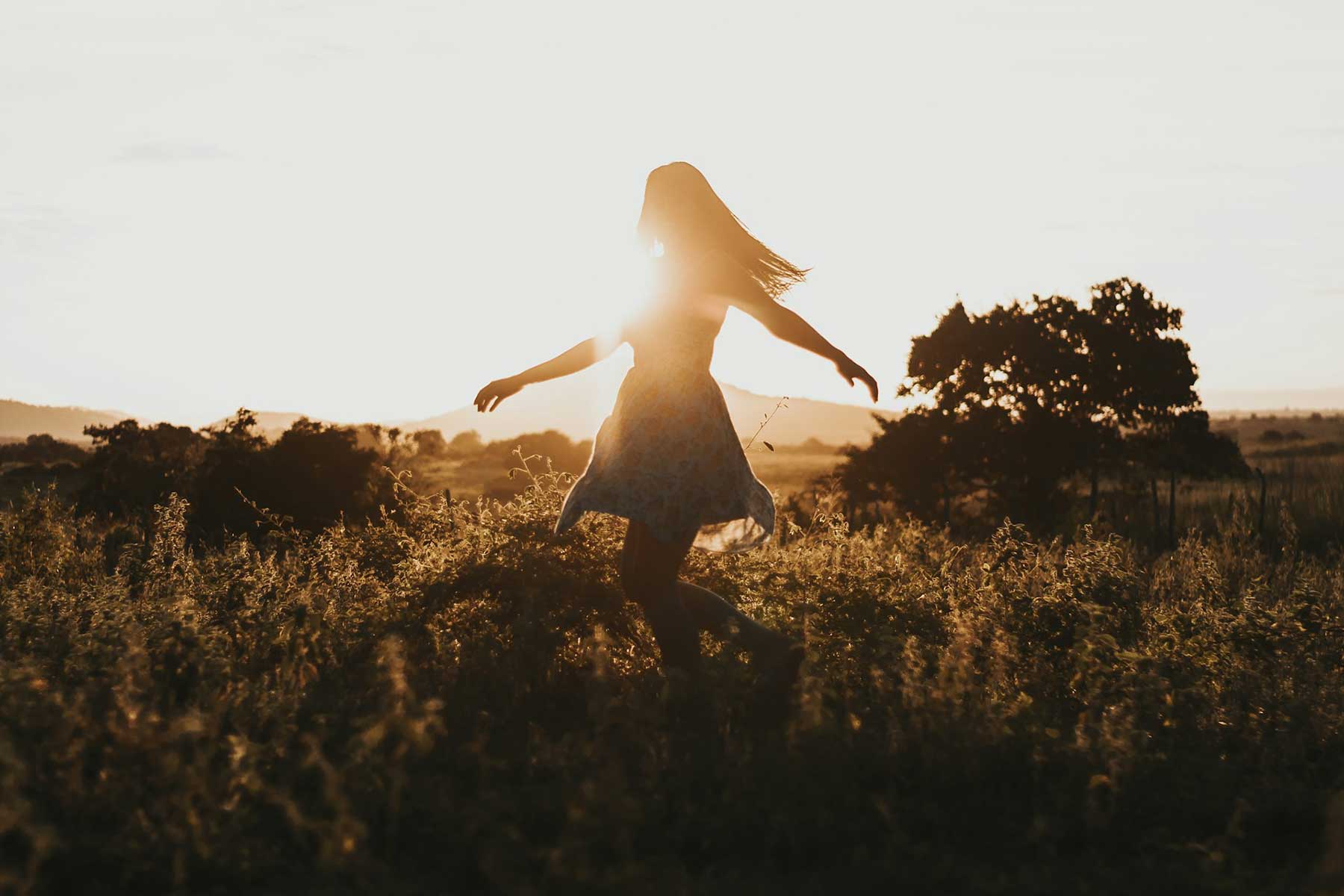
Emotion and Individualism: Romantic art focused on the expression of strong emotions, such as awe, terror, and sublime beauty. It celebrated individualism and the artist's personal response to the world.
Nature and the Sublime: There was a deep fascination with nature, not just as a backdrop for human activity, but as a living force. The concept of the sublime - nature's overwhelming and awe-inspiring beauty that evokes deep, often spiritual, emotions - was central.
Nationalism and Exoticism: Romantic artists and writers often emphasized local folklore, history, and landscapes, contributing to a sense of nationalism. There was also an interest in the exotic and unfamiliar, spurred by increased travel and exploration.
Mysticism and the Supernatural: Many Romantic works include elements of the supernatural and the mystical, reflecting a world where the fantastic and the real coexist.
Heroism and the Past: The movement often idealized heroes, heroic actions, and the past, particularly the medieval era and its chivalric codes.
Painters: Caspar David Friedrich (our Master Artist this month), J.M.W. Turner, Eugène Delacroix, Francisco Goya, John Constable, Rosa Bonheur, Marie Ellenrieder
Poets and Authors: The movement also profoundly influenced literature. Key figures include William Wordsworth, Dorothy Wordsworth, Caroline Norton, Sir Walter Scott, Mary Shelley, Emily Brontë , Elizabeth Barrett Browning, Samuel Taylor Coleridge, Lord Byron, Percy Bysshe Shelley, John Keats, Victor Hugo, and Johann Wolfgang von Goethe.
Musicians: In music, Romanticism influenced composers like Ludwig van Beethoven, Franz Schubert, Frédéric Chopin, Fanny Mendelssohn, Richard Wagner, and Johannes Brahms, who expressed deep emotion and nationalism in their compositions.
The Romantic period produced a wealth of literature that continues to captivate readers with its emphasis on emotion, nature, and individualism. Here's a list of highly recommended books and poems from this era:
"Frankenstein" by Mary Shelley (1818): A cornerstone of Gothic and Romantic literature, this novel explores themes of creation, humanity, and the sublime.
"Wuthering Heights" by Emily Brontë (1847): A tale of passionate and tragic love, set against the backdrop of the Yorkshire moors.
"Pride and Prejudice" by Jane Austen (1813): While Austen's work is often seen as more closely aligned with the Enlightenment, her focus on individual feelings and social criticism aligns with Romantic sensibilities.
"Jane Eyre" by Charlotte Brontë (1847): A novel that combines Gothic mystery, a deep sense of morality, and a strong, complex heroine.
"Ivanhoe" by Sir Walter Scott (1820): A historical romance that popularized the Middle Ages, combining adventure, history, and chivalry.
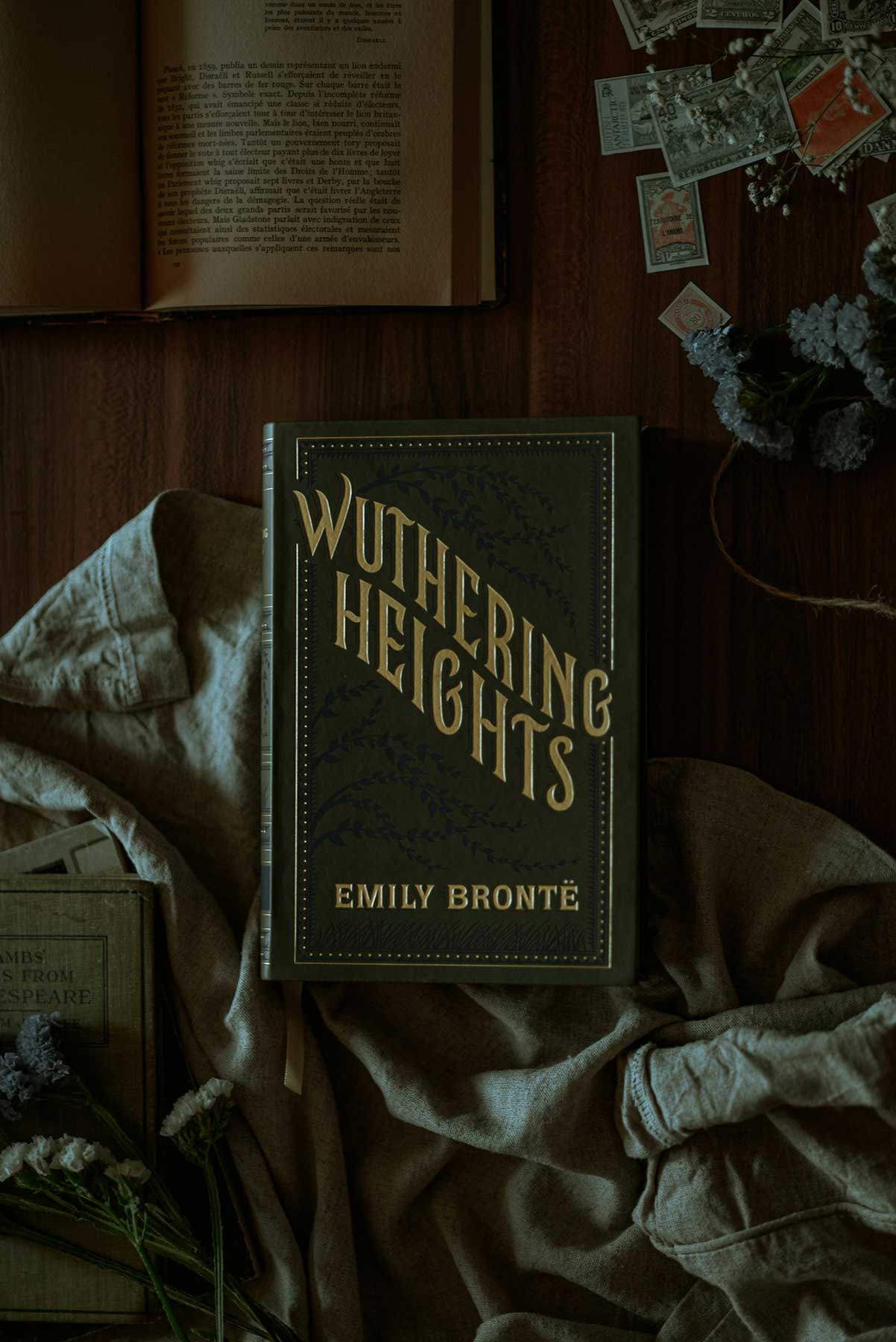
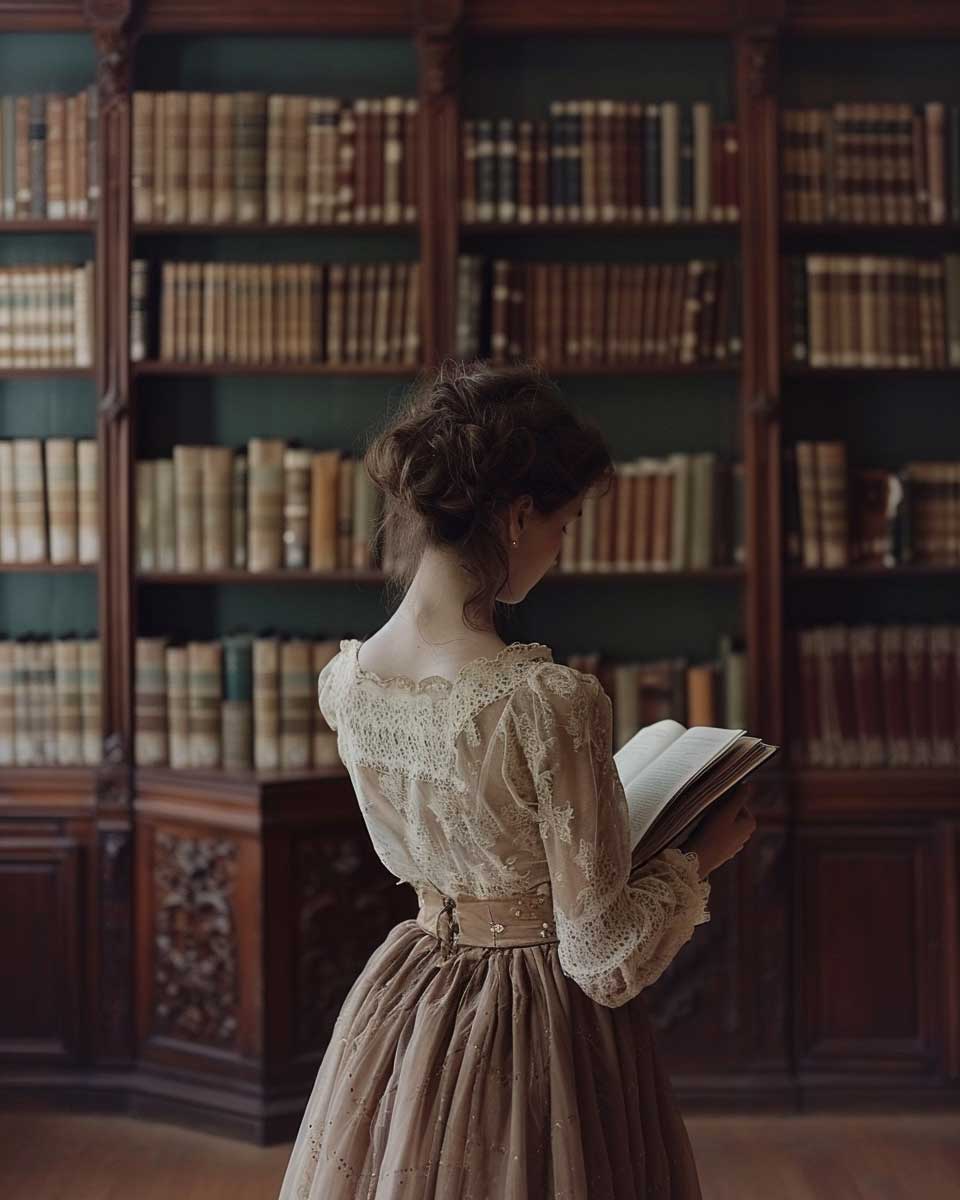
"Lyrical Ballads" by William Wordsworth and Samuel Taylor Coleridge (1798): This collection is often considered the starting point of English Romanticism, featuring classics like "Lines Composed a Few Miles Above Tintern Abbey" and "The Rime of the Ancient Mariner."
"Don Juan" by Lord Byron (1819-1824): A satirical epic that is both humorous and an insightful commentary on society.
"Ode to the West Wind" by Percy Bysshe Shelley (1820): A powerful poem expressing the poet's longing for change and transformation.
"Ode to a Nightingale" and "To Autumn" by John Keats (1819): These odes are some of the most famous works of Romantic poetry, rich in sensual imagery and exploring themes of nature, beauty, and mortality.
"Songs of Innocence and of Experience" by William Blake (1789, 1794): A collection of poems showing two contrary states of the human soul, combining beautiful imagery with social critique.
The word spirit originates in the Latin spirare, meaning to breathe. This emphasis on respiration, or movement of life force, provides an excellent framework for considering renewal or revival. How do we unearth the essence of Romanticism and breathe life into it in a personally significant way?
A good starting point is to consider the qualities that defined the Romantics. From there, we can apply those traits to our own creative work. Through this process, we will reinvigorate our art by tapping into how something greater than ourselves, more universally meaningful, can often be best conveyed through deeply felt personal expression.
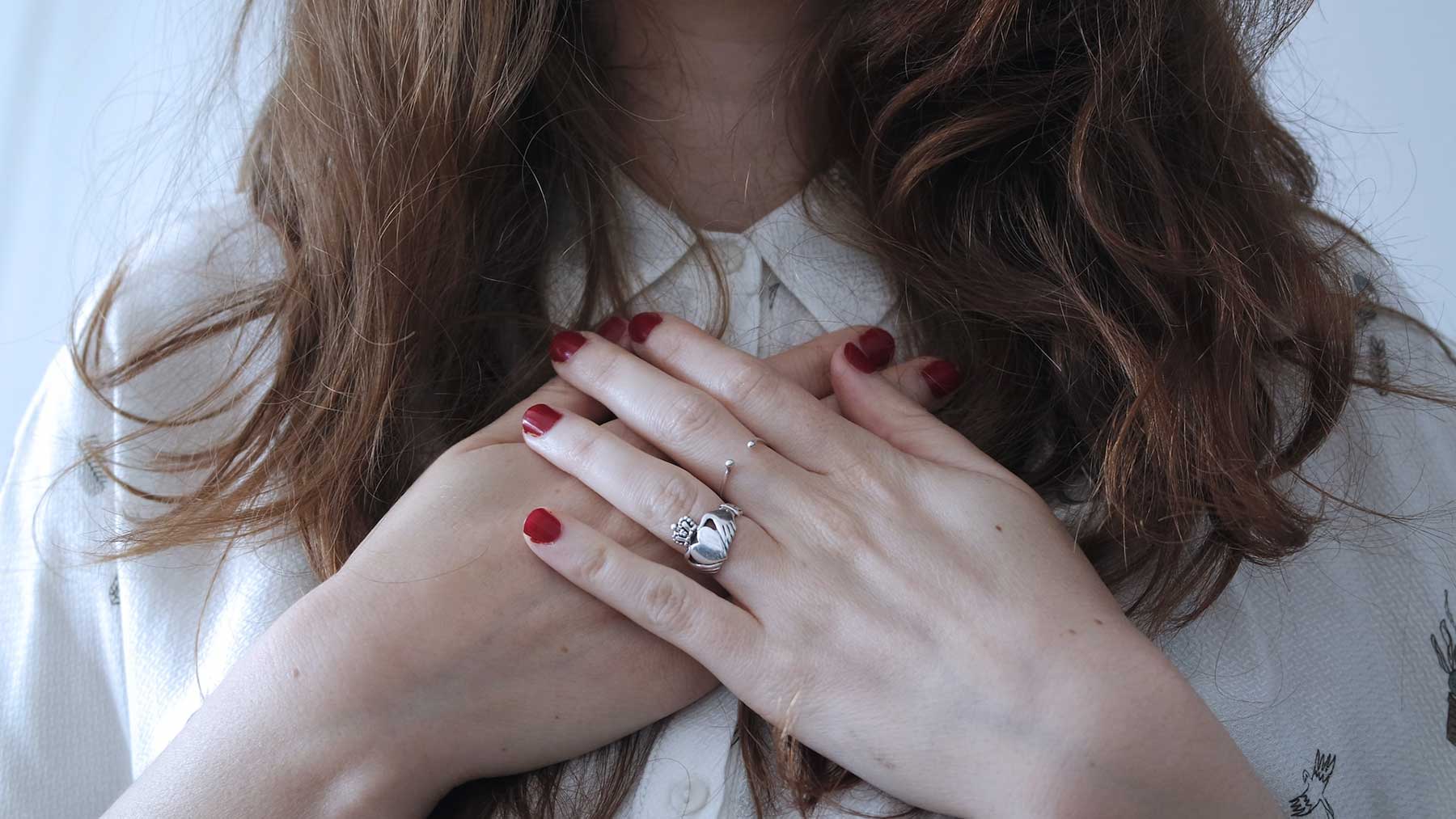
The Romantic movement grew out of the spirit of the French Revolution, which emphasized liberty, equality, and brotherly love. The artists of this period were actively sloughing off the realism that defined the Enlightenment era and opting for inspired, subjective, pre-eminently individual works.
Rather than fighting to make their art appear objectively life-like, they focused on their feelings and how their emotions spontaneously influenced the nature of the piece.
Naturally, this meant that the concerns of the moment, the political and social issues at center stage, influenced the character of their work. So, too, did their personal lives replete with the whole gamut of emotional states. The result was dramatic, idealized, exaggerated, and poignant works that made you fall in love with the beauty of the scene or recoil at the horror of what nature and man could unleash upon the world. Because the art of this era was unabashedly personal and utterly unrestricted, it was emotionally evocative, which is why it continues to stir us to this day.
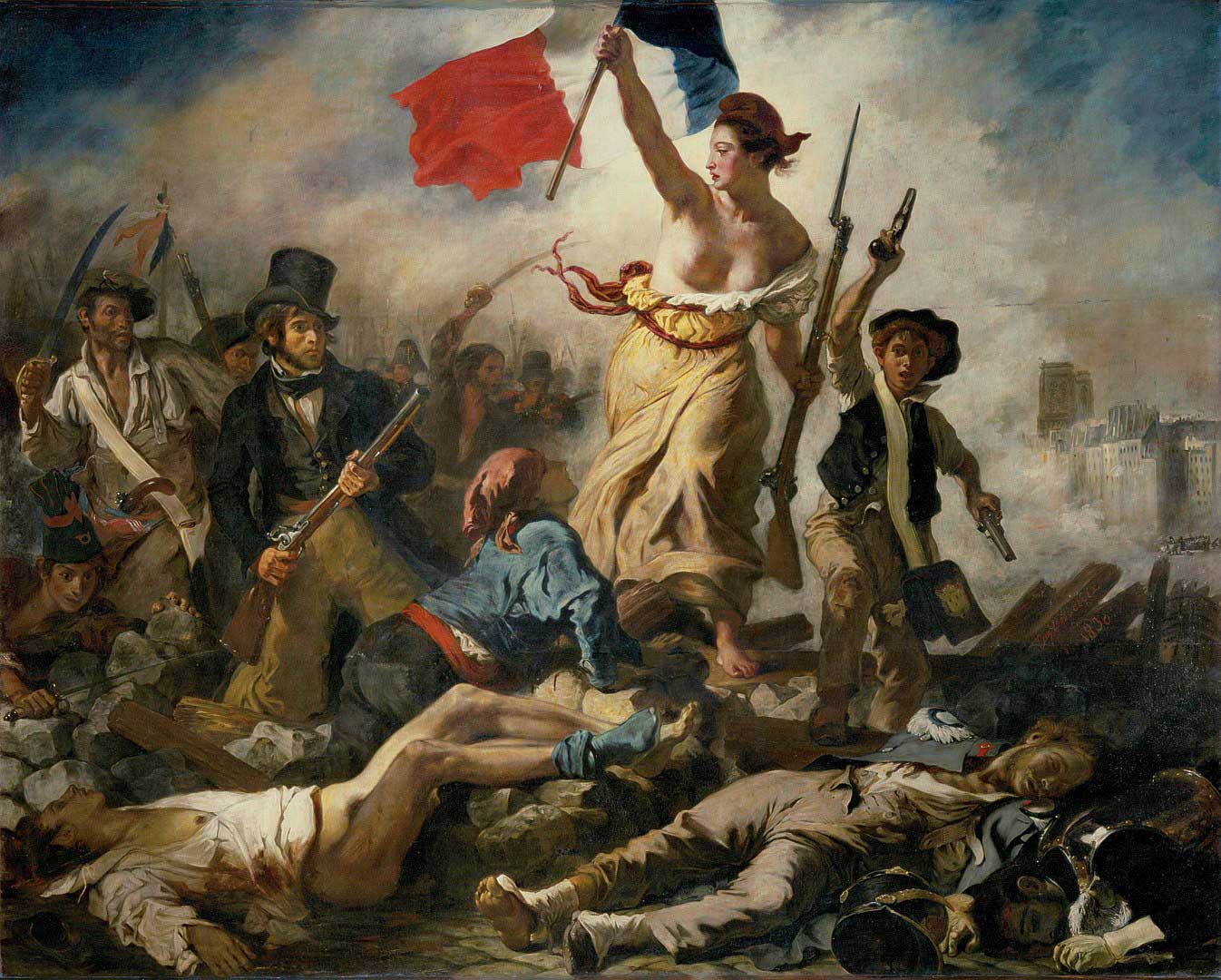
Liberty Leading the People
Eugène Delacroix, 1830
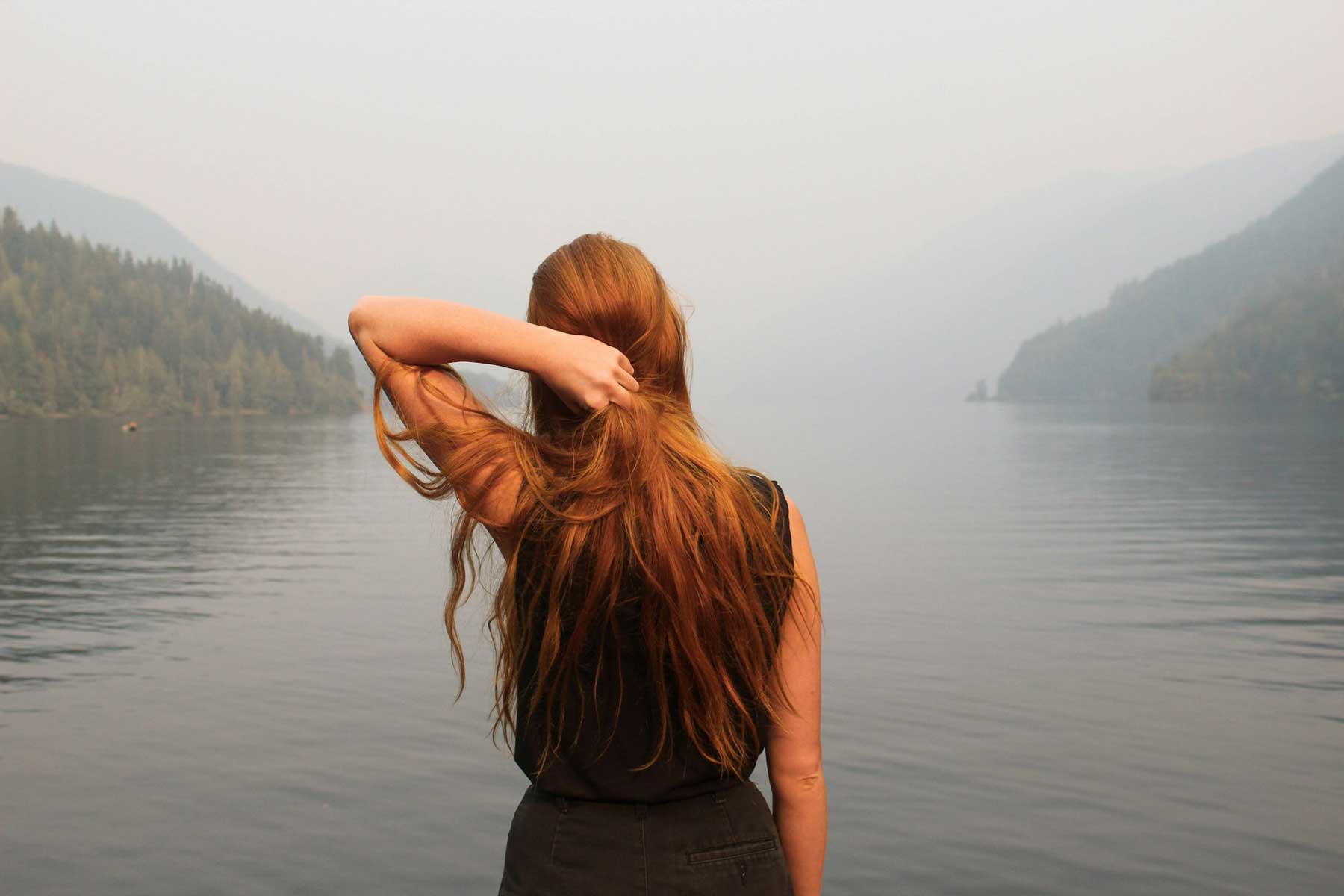
The central point is to explore not only what is beautiful but also what best reveals your inner journey, whether strange, frightening, or glorious. There is no right way to do this other than to free yourself to examine the world in a highly personal way and be bold enough to share what you see.
Dig into what makes your emotions surge to life and visualize what those feelings might look like. For example, they may resemble a stormy sea, a serene meadow, the light of love in someone’s eyes, the choking smog from a smokestack, the luminous glow of the setting sun, a solo traveler in a barren wasteland, a crowded room of raucous revelers, an aurora in the heavens, mystical, magical beasts, angels or devils. You can zoom in or out and pick any subject you like; let your imagination loose.
When you’ve selected your subject, consider your relationship with it. What is the energy there? How does that make you feel? What are the shapes, colors, and contours that best express this? Enjoy the process and let it run wild; all that is required is to dive into your felt experience and let that fuel what you portray.
The way of the romantic artist is a lived one. To authentically share something of your inner self entails a consciousness of your daily experience that elects to view all things as meaningful. This process imbues even the most mundane things with an edge of mystery or appeal, a close consideration that reveals that everything everywhere has a story; it’s just that we’re sometimes too preoccupied to see it.
By attuning our eyes to look deeply, we will see more, feel more, and more thoroughly engage with our moments. In so doing, we will fall in love with life in all its wild diversity, and this is what will revive the romantic spirit, breathing life into our art.
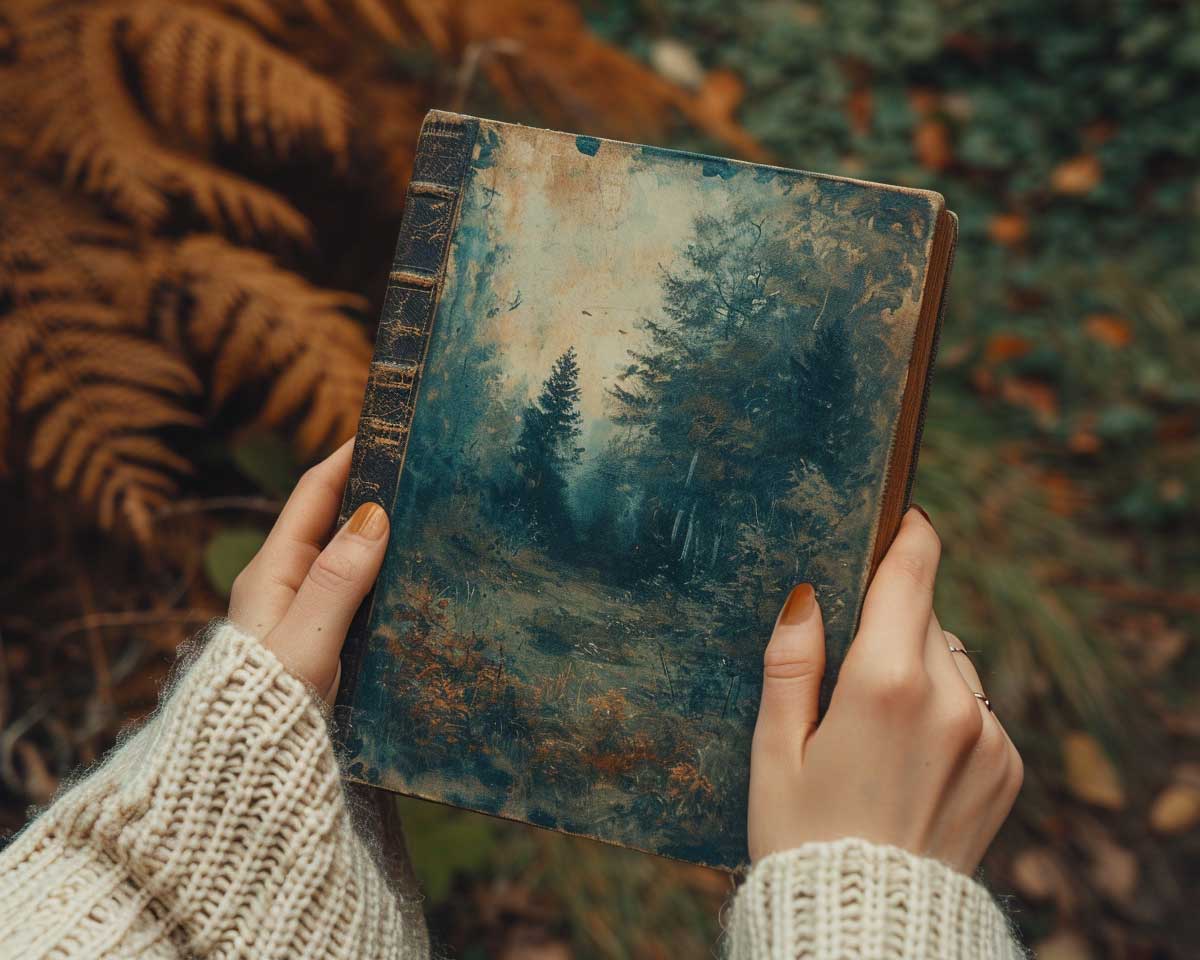
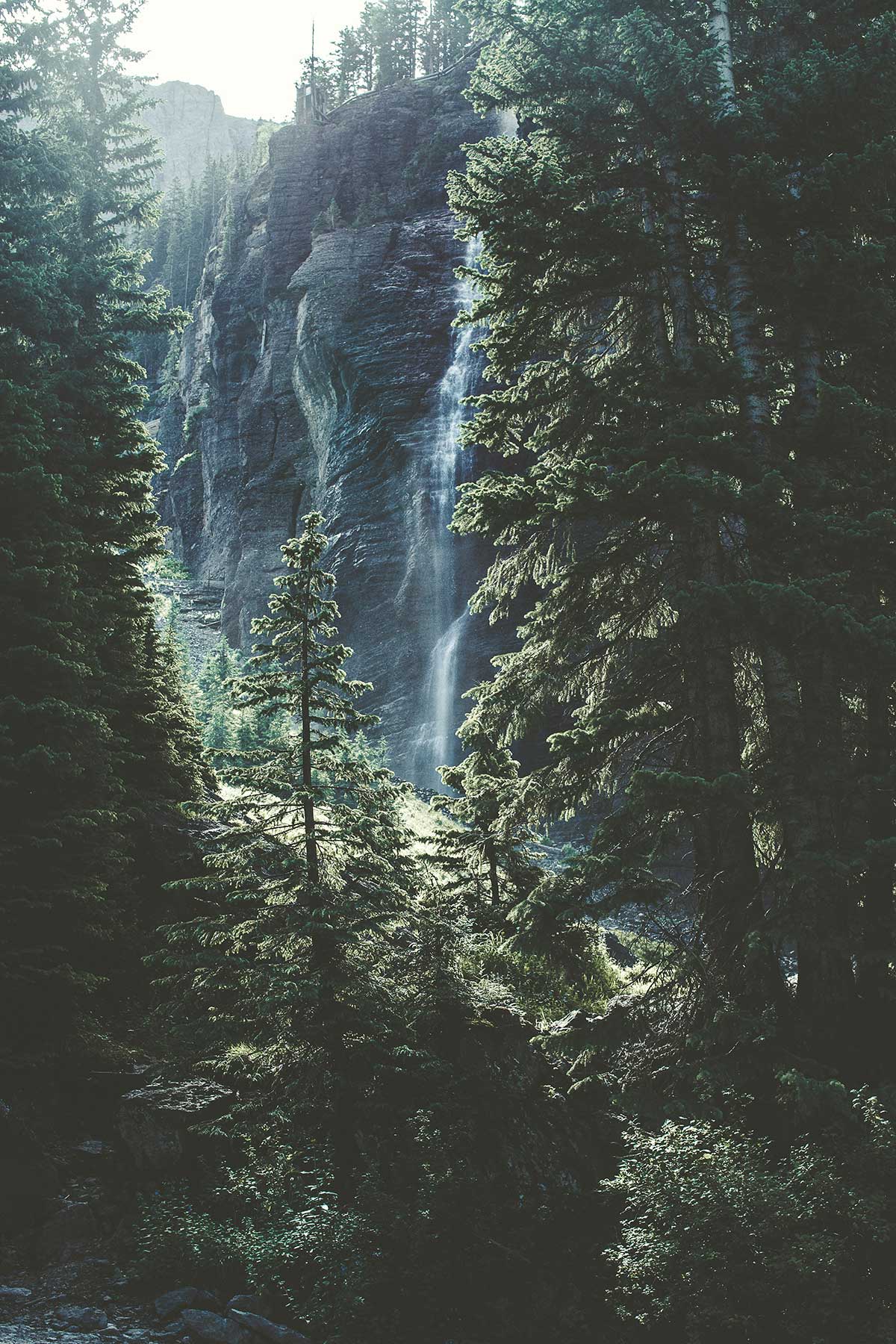
This definition aligns closely with the aesthetic and philosophical concept of the sublime, which is a key element in Romanticism. It refers to something that is not just beautiful, but also has an overwhelming quality that can inspire a profound sense of awe, wonder, or reverence. This could be a natural landscape, a work of art, or any other experience that transcends the ordinary and evokes a powerful emotional response.
In relation to artists inspired by Romanticism, the concept of the sublime is particularly significant. Romantic artists and writers were fascinated by the power of nature and the vastness of the human experience, often seeking to capture and convey the awe-inspiring, sometimes overwhelming, aspects of both. They aimed to evoke strong emotional responses in their audience, encouraging a deep, often spiritual engagement with their work.
The sublime in Romanticism is often associated with nature's grandeur and power – towering mountains, turbulent seas, expansive skies – which can induce feelings of awe, smallness, and an awareness of the sublime beauty and terror of the natural world. This concept encouraged artists to explore themes that transcended the mundane, seeking to touch upon the profound mysteries of life, death, nature, and human emotion.
Let’s tap into our creative intuition and do some self-reflective work inspired by our theme. Below you will see our month’s Oracle/Tarot card spread. But fear not, if you are not one drawn to using oracle or tarot cards, no worries, just use the accompanying reflective questions as writing prompts for your journals!
THE ROMANTIC'S JOURNEY
Card 1: The Heart of Nature
Position: Left
Focus: This card represents your current connection to and understanding of nature.
Reflective Question: "How is nature speaking to me at this moment, and what is it teaching me about my own existence?"
Card 2: The Sublime Within
Position: Center
Focus: This card explores your inner emotional landscape, particularly feelings of awe, wonder, or the sublime.
Reflective Question: "What aspects of my life or my inner self currently evoke a sense of the sublime or profound wonder?"
Card 3: The Artist's Vision
Position: Right
Focus: This card suggests how you can express or integrate these experiences of nature and the sublime into your creative endeavors or personal growth.
Reflective Question: "In what ways can I channel my experiences of nature’s beauty and the sublime into my art or daily life?"
Card 4: The Romantic Challenge
Position: Below Center
Focus: This card identifies a challenge or obstacle in embracing or expressing the Romantic ideals in your life.
Reflective Question: "What barriers must I overcome to more fully engage with the Romantic spirit in my life and work?"
Card 5: The Path Forward
Position: Above Center
Focus: This card provides insight into future possibilities or paths that may open as you connect more deeply within.
Reflective Question: "What future opportunities or paths might unfold as I deepen my connection with nature, the sublime, and my creative expression?"
HOW TO USE THE SPREAD
Find a peaceful and comfortable space where you can be reflective and undisturbed.
As you shuffle your oracle deck, focus on your desire to connect with the themes of Romanticism, the beauty of nature, and the experience of the sublime.
Draw five cards from the deck and place them in the order mentioned above.
For each card, spend some time contemplating its imagery and how it resonates with the aspect it represents (Heart of Nature, Sublime Within, Artist's Vision, Romantic Challenge, Path Forward).
Use the reflective questions as a guide to delve deeper into each card's significance and what it reveals about your journey.
This spread is designed to help you explore and integrate the themes of Romanticism into your personal and creative life, encouraging a deeper connection with nature, emotion, and artistic expression. Remember, the interpretations are subjective and personal; trust your intuition and insights as you reflect on each card.
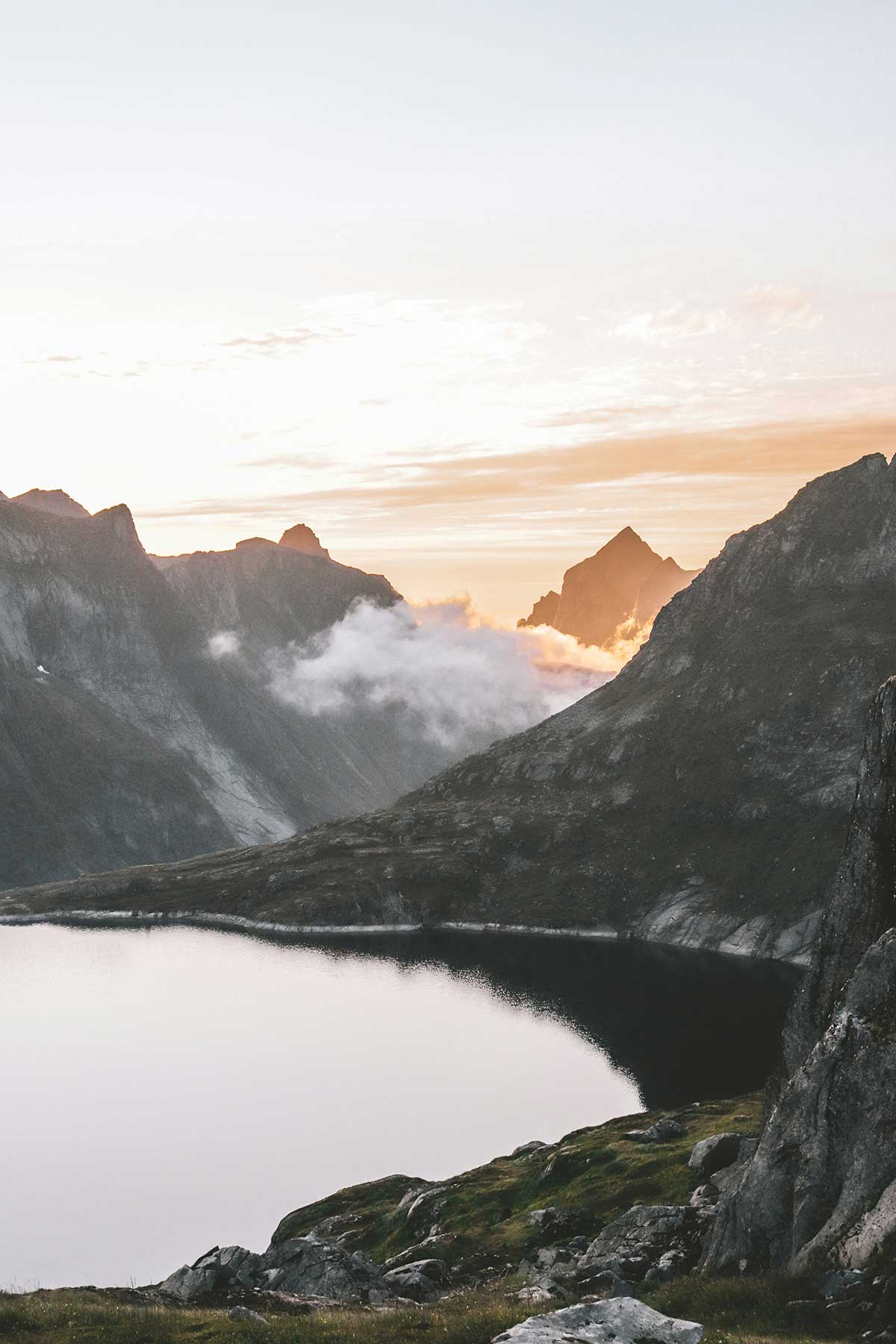
I am sharing this beautiful meditation from one of my favorite meditation masters - Rachel Hillary. This journey will help you connect to the power of your own soul rivaled only by the power of nature.
Rachel will share a little about this experience -
Welcome to Heart Mountain. This is an experimental adventure transmission, where we find ourselves on top of a beautiful mountain, and begin to use our own heart centre and its powerful energy, to welcome in any pain or suffering we may be experiencing ourselves, or others may be experiencing, and allow the heart space to alchemise these, welcoming them back home, to the heart space, transformed by light. I believe in the power of the heart, let us see if together we can send waves of love.
lots of love,
Rachel
Each month we will have a positive affirmation. I recommend you print out this affirmation and put it in your sketchbook or somewhere in your studio. Recite the affirmation out loud each time you show up to create. Saying words aloud is powerful and can begin to re-write some of our own limiting beliefs or calm our fears. Try it now…
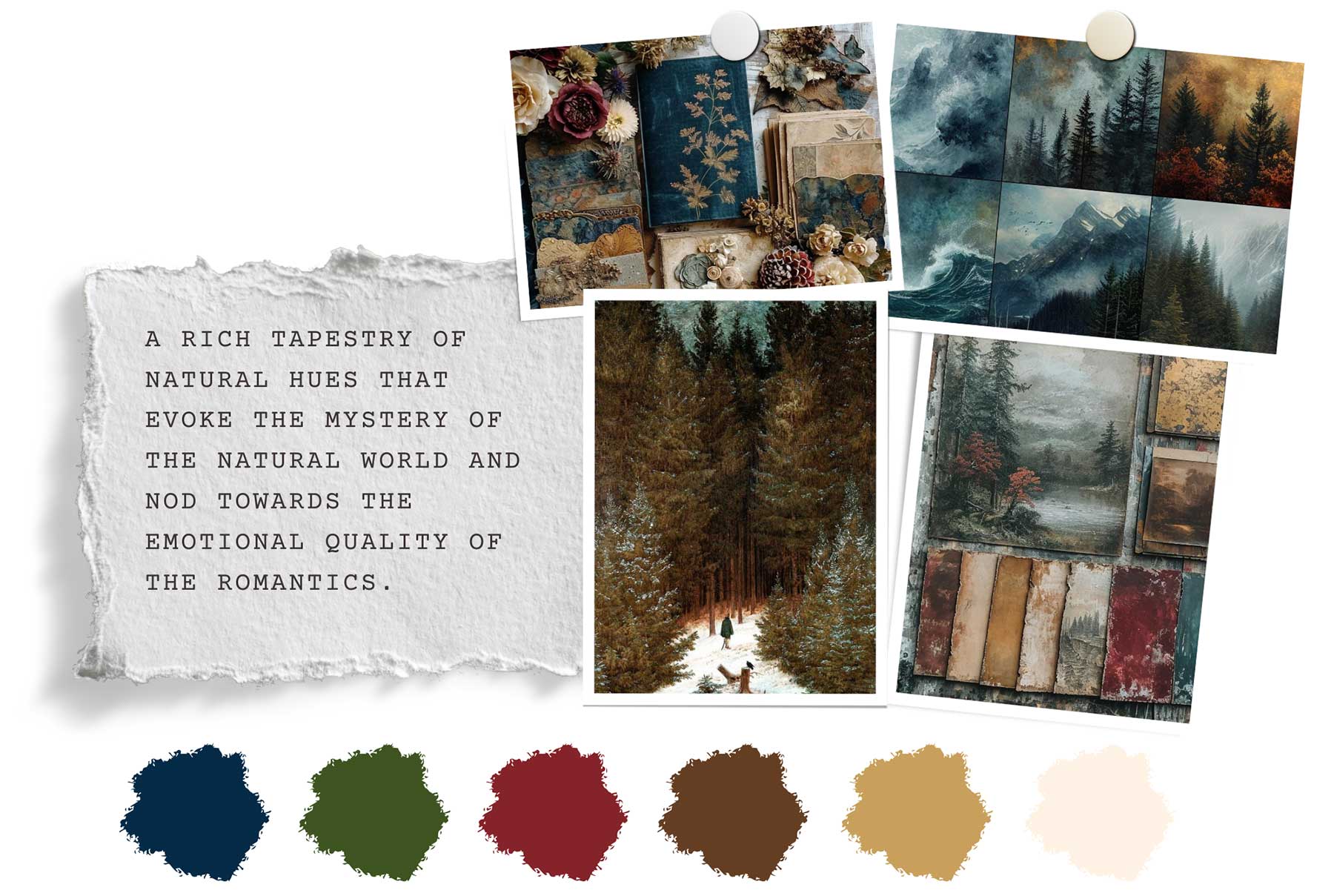
In this month's artistic journey, we delve into the heart of Romanticism, drawing inspiration from the sublime beauty of the natural world and the depth of human emotion. Our chosen color palette is a homage to these themes, carefully selected to evoke the richness, mystery, and awe inherent in both nature and the Romantic spirit.
Deep Forest Green: This lush, vibrant hue is our tribute to the enigmatic depths of the forest - a symbol of life, growth, and the mysteries that lie within the heart of nature.
Midnight Blue: Reminiscent of a clear, star-studded night sky, this color speaks to the vastness and profound beauty of the universe, inviting contemplation of the sublime.
Burgundy Red: Intense and full of emotion, this color echoes the depth of human passion and the core of our most profound experiences and desires.
Burnt Umber: Rooting our palette in the foundation of the earth, this color represents stability, resilience, and our intrinsic connection to the natural world.
Gold or Warm Amber: A touch of the ethereal, this shimmering color brings a sense of light, inspiration, and the magical moments of twilight when the world is alight with the glow of the setting sun.
Cream: Offering a peaceful and calming counterpoint to the more intense colors, this neutral shade represents tranquility, purity, and the canvas of possibility.
Each color in this palette has been chosen not just for its aesthetic appeal, but for its ability to convey a specific aspect of the Romantic and natural sublime. Together, they form a harmonious symphony of colors that are deeply evocative, richly emotive, and profoundly connected to the natural and emotional landscapes that inspire us.
This month, we turn our focus to Caspar David Friedrich, a master whose work profoundly resonates with our themes of Romanticism and the sublime. I have chosen Friedrich for his exceptional ability to capture the intricate relationship between humanity and the awe-inspiring beauty of nature. His paintings are more than landscapes; they are emotional narratives that embody the Romantic spirit, making him an ideal subject for our exploration. Through studying Friedrich, we aim to deepen our understanding of how art can transcend the visual, connecting us with the profound depths of emotion and the sublime wonders of the natural world.
Caspar David Friedrich, born on September 5, 1774, in Greifswald, a small town in Pomerania, which was then part of Sweden, is often hailed as one of the most important figures in the Romantic movement in art. His life and work were deeply intertwined with the Romantic ethos, which emphasized emotion, nature, and introspection.
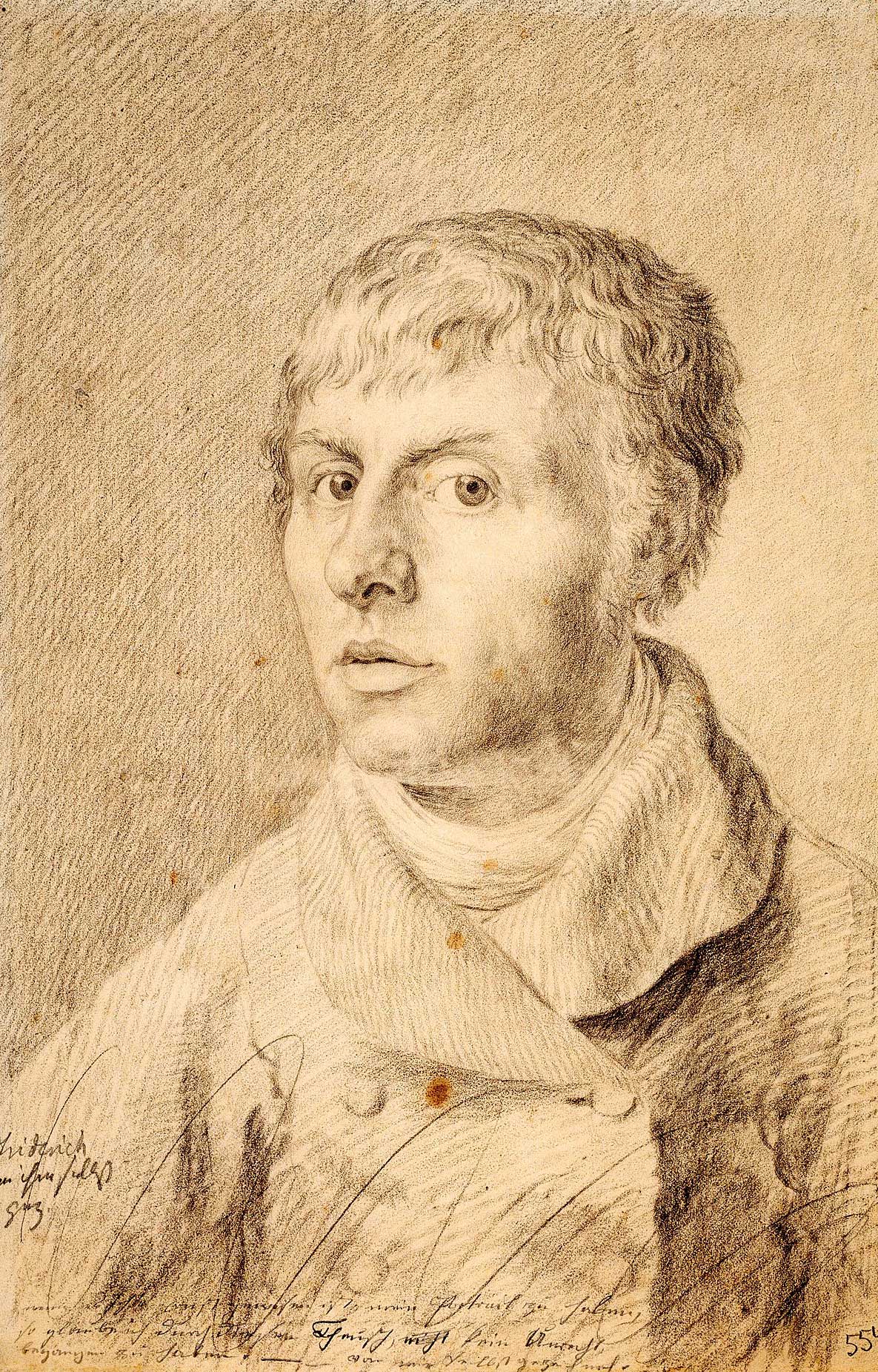
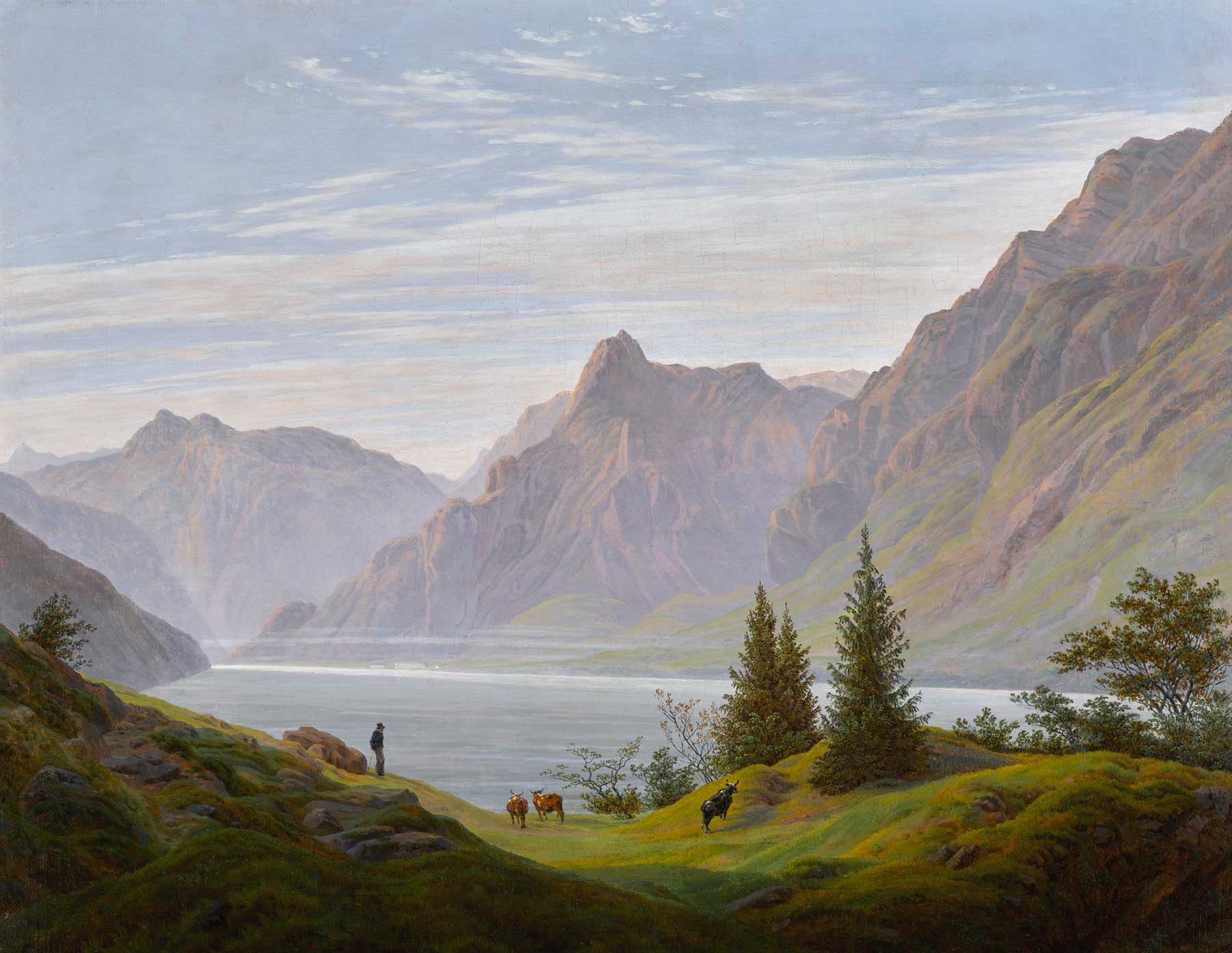
Landscape With Mountain Lake, Morning
Casper David Friedrich, 1823
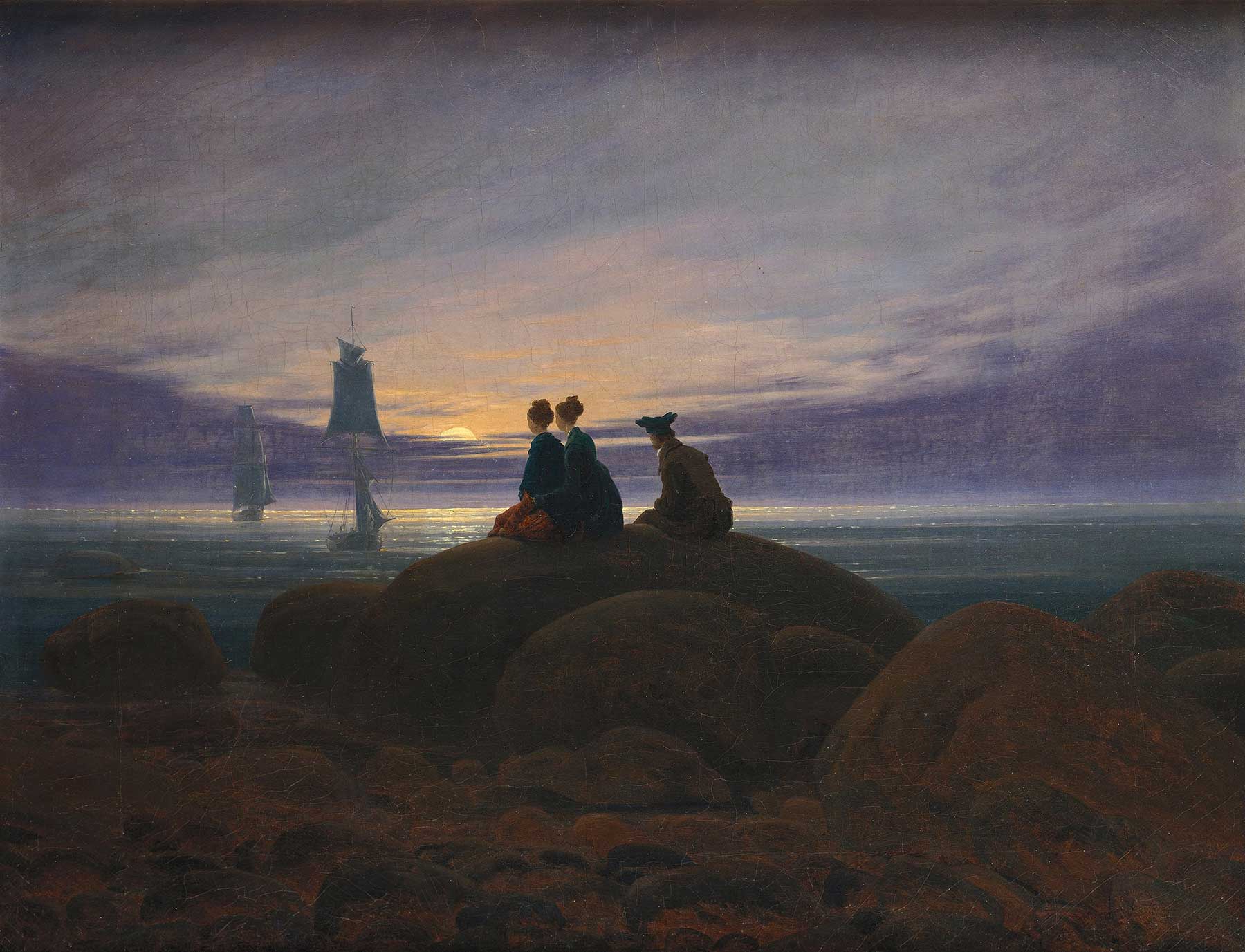
Moonrise over the Sea
Casper David Friedrich, 1822
Friedrich was born into a family with ten children, and he experienced significant personal loss early in life, including the death of his mother when he was just seven and later, the tragic loss of a brother. These early experiences of grief and loss had a profound impact on his sensibility and artistic themes.
He began his formal art education at the University of Greifswald and later studied at the prestigious Academy of Copenhagen. His early work was influenced by the prevailing styles of the time, including the work of artists like Asmus Jacob Carstens and Jens Juel.
Friedrich's mature style emerged in the early 19th century and was marked by a distinct focus on landscape. However, unlike many of his contemporaries, Friedrich's landscapes were not mere representations of nature; they were imbued with symbolism, emotion, and a sense of the sublime. His works often featured elements such as barren trees, ruins, and solitary figures, set against vast skies or seas. These elements were not just aesthetic choices but were laden with spiritual and metaphysical significance.
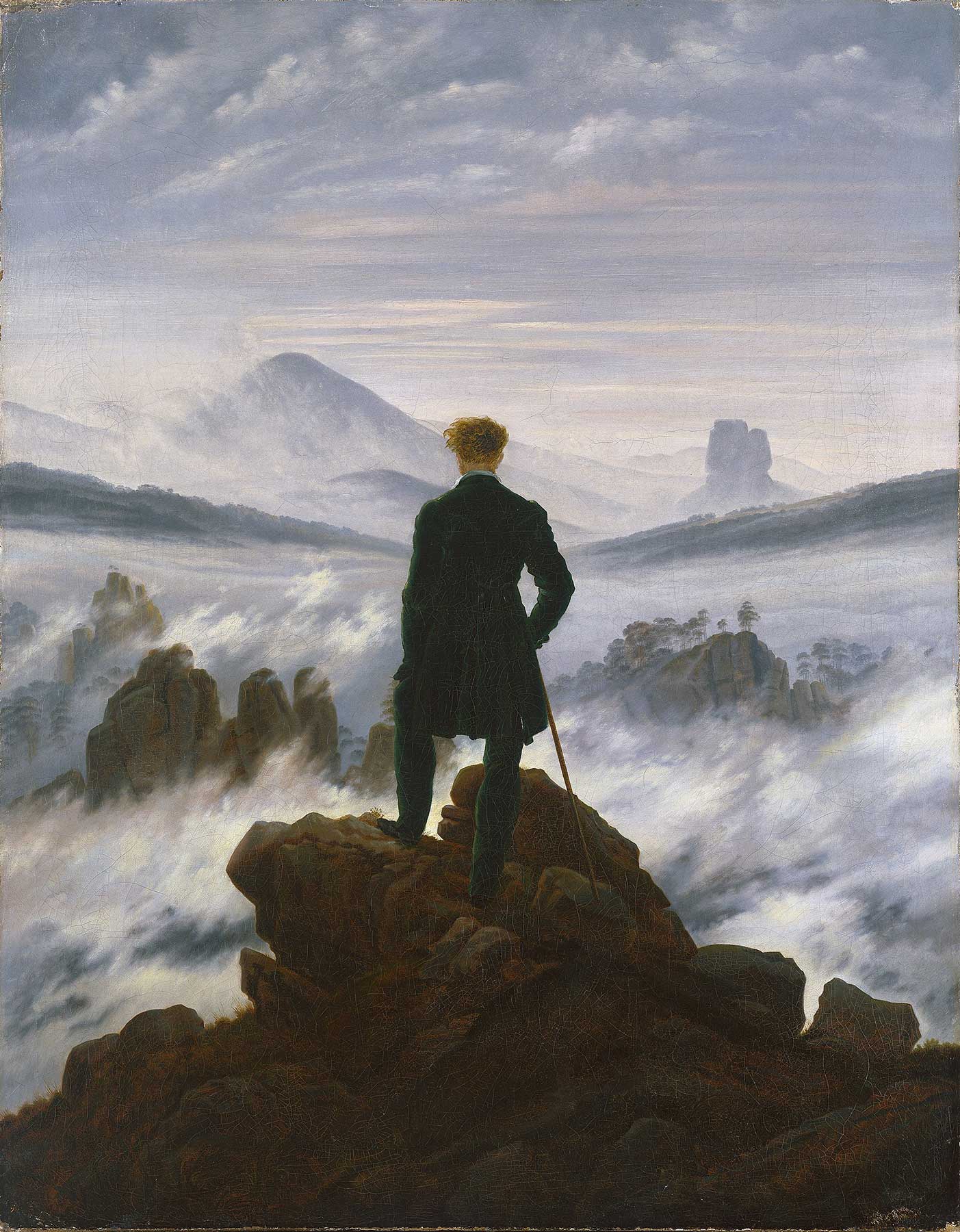
Wanderer above the Sea of Fog
Casper David Friedrich, 1818
Friedrich's work epitomizes the Romantic movement's preoccupation with the awe-inspiring, often terrifying aspects of nature that evoke a sense of the divine or the transcendent. His landscapes are reflective and introspective, inviting the viewer to contemplate their own place in the world and their relationship to nature and the Universe.
His use of light and shadow, particularly the portrayal of dawn, dusk, and moonlight, contributed to the mood of his paintings and emphasized the transient, ephemeral nature of human experience in contrast to the enduring, majestic quality of the natural world.
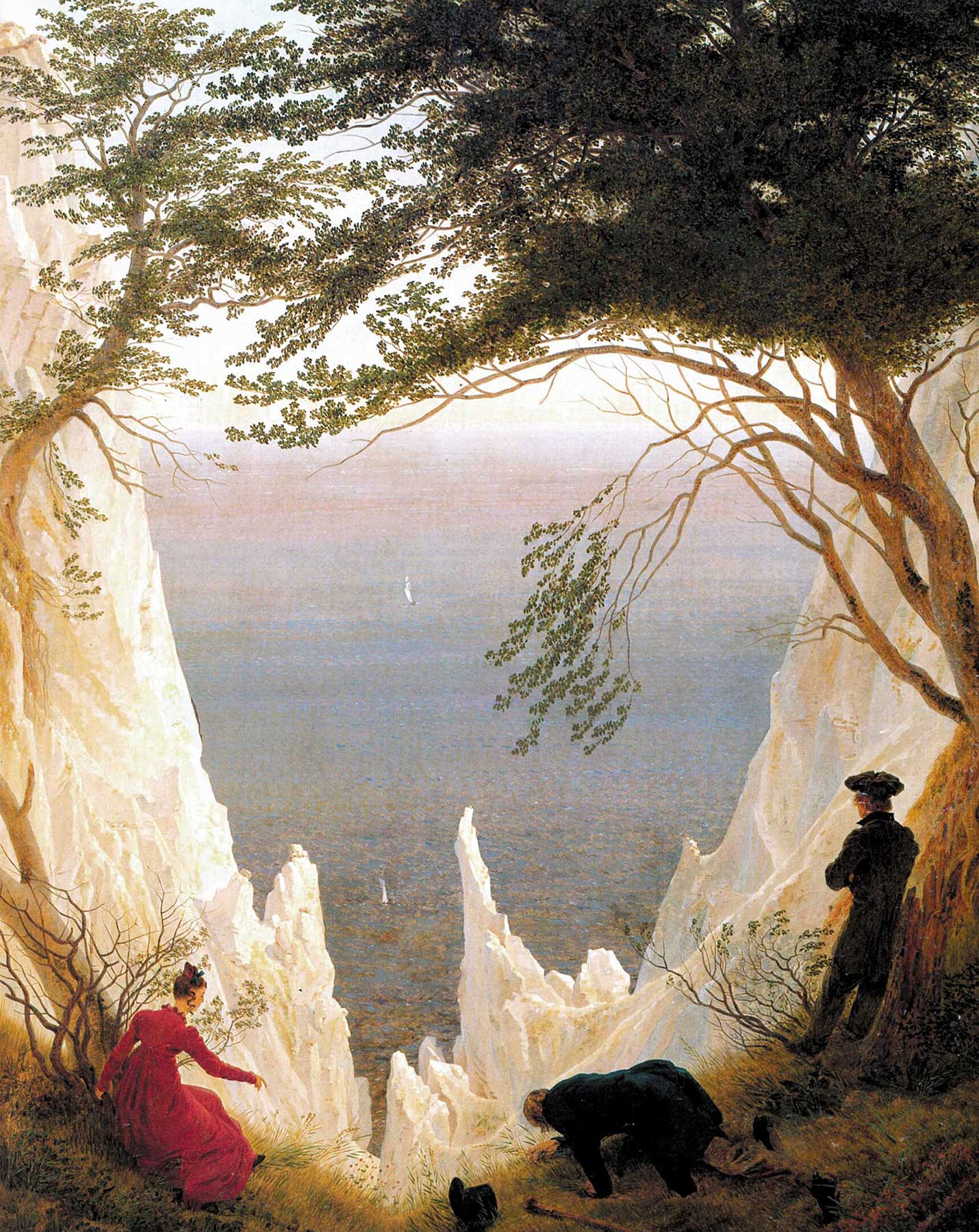
Chalk Cliffs on Rügen
Casper David Friedrich, 1818
Friedrich was a deeply private individual and remained somewhat isolated in his personal and professional life. His work received mixed reviews during his lifetime, and his popularity waned in his later years. He died in obscurity in 1840. However, his work was rediscovered in the 20th century and he is now celebrated as a key figure in the Romantic movement and as one of the most important landscape painters of the 19th century.
Friedrich was influenced by the broader cultural and philosophical movements of his time, including German Romanticism and the writings of philosophers like Immanuel Kant and Johann Wolfgang von Goethe, who explored the sublime and the interplay between nature and human emotion. His work also reflects a deep engagement with the natural world and a personal spirituality that was characteristic of Romanticism.
As we reflect on Caspar David Friedrich's legacy, we recognize his profound impact on the world of art. Friedrich was more than a painter; he was a visionary who captured the sublime mystery of nature, deeply influencing the Romantic movement and beyond. His works, marked by their emotional depth and spiritual introspection, continue to resonate with audiences, inspiring a deeper connection with the natural world.
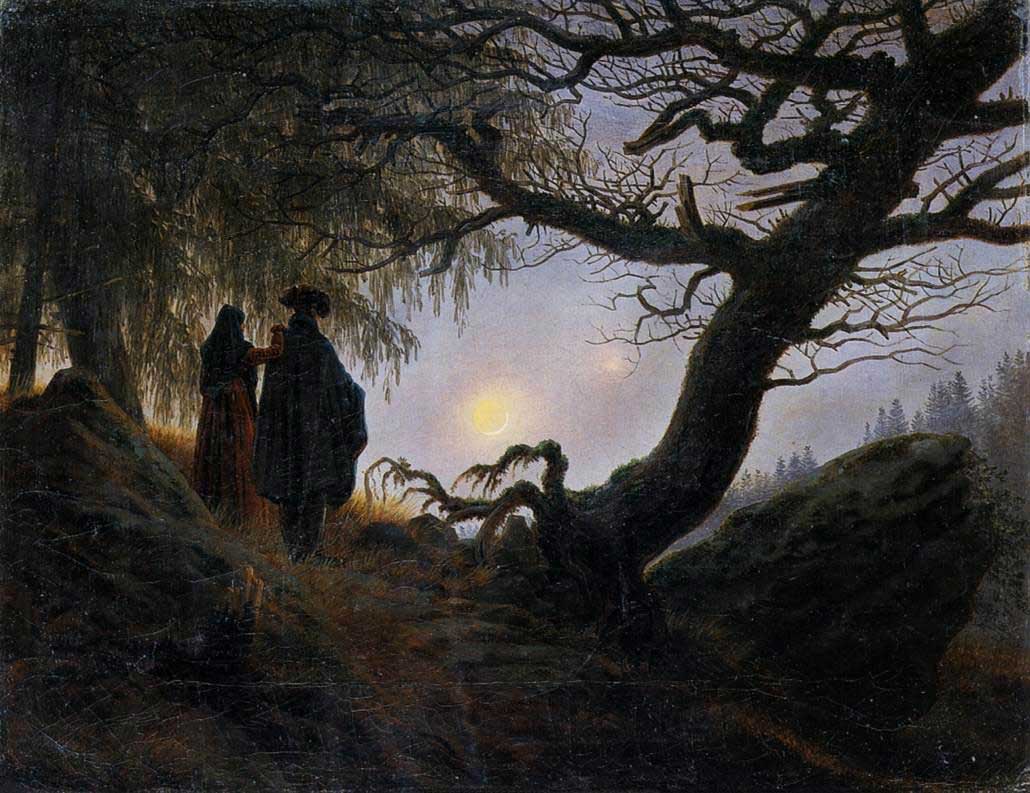
Man and Woman Contemplating the Moon
Casper David Friedrich, 1824
Sketch an imaginary or referenced landscape that combines elements of the sublime - towering mountains, vast oceans, deep forests or wide open valleys. Try to capture the awe-inspiring beauty of nature. I’ve curated a gallery for you...
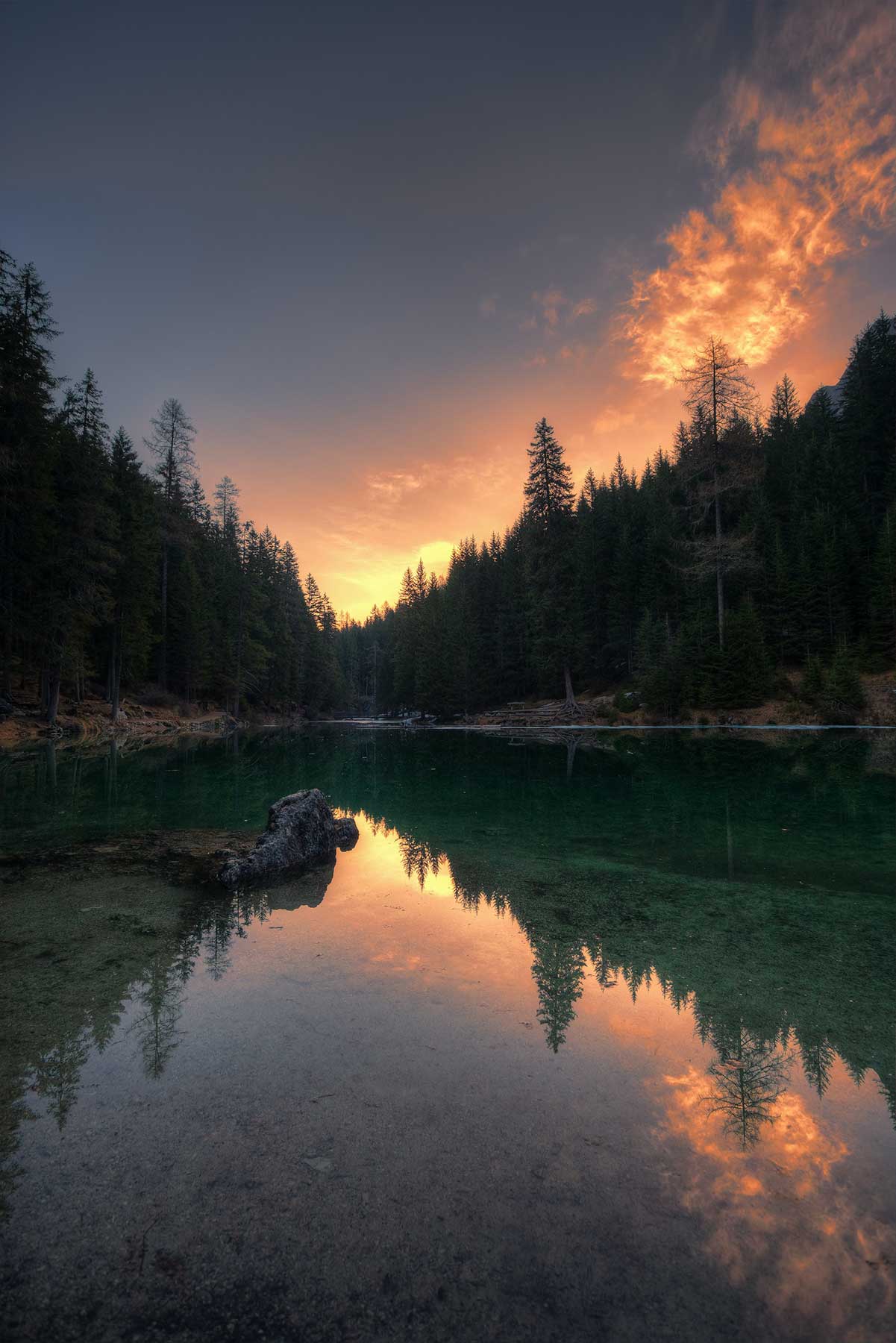
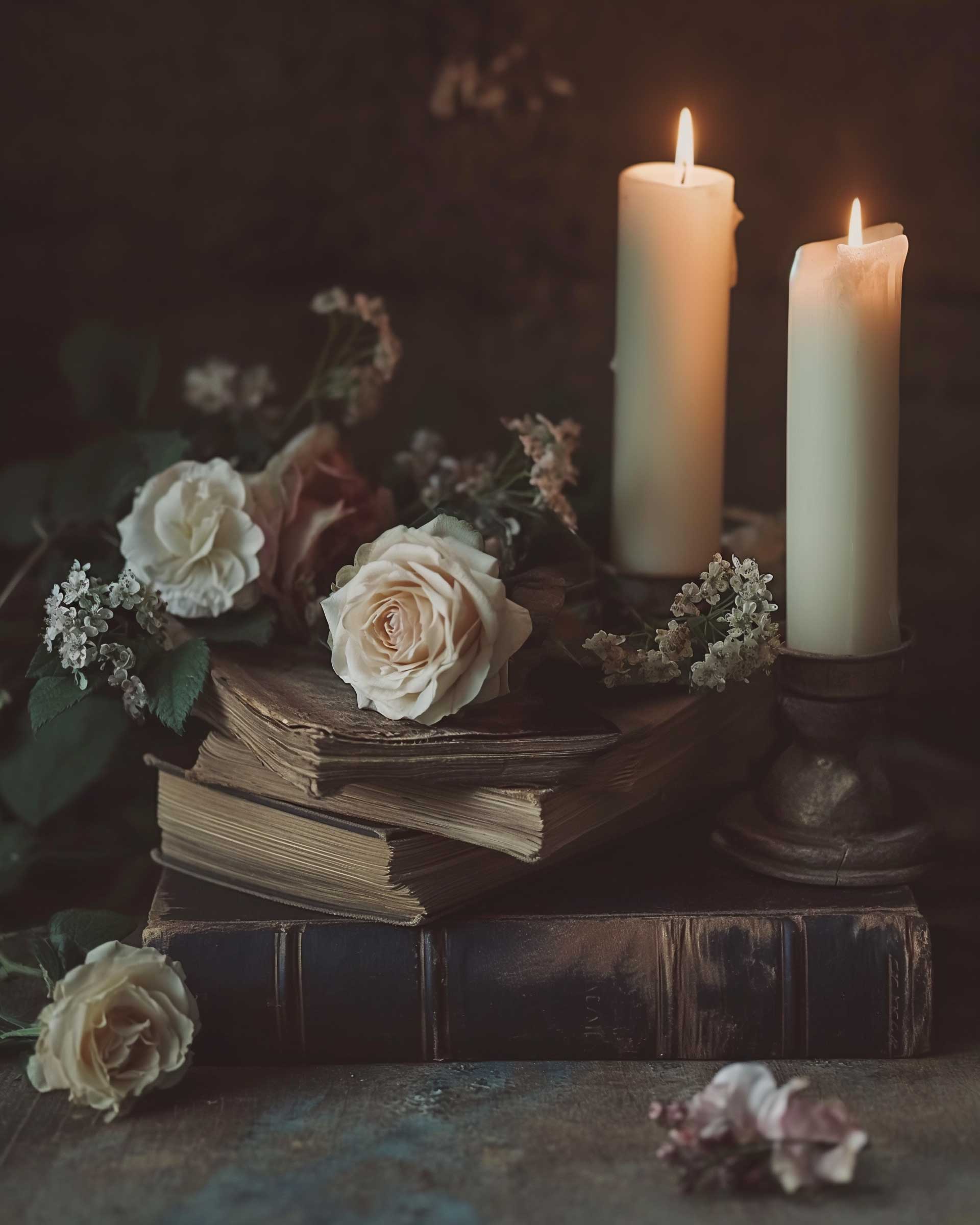
Arrange and sketch a still life that includes objects symbolizing the Romantic era – old books, candles, vintage letters, and natural elements like flowers or a plant. I have some beautiful reference photos to get you inspired too!
Sketch and/or paint characters in Romantic-era clothing, perhaps caught in a moment of introspection. I’m especially inspired by Emily Brontë’s Wuthering Heights heroine, Catherine. Here are some lovely reference images inspired by this character.
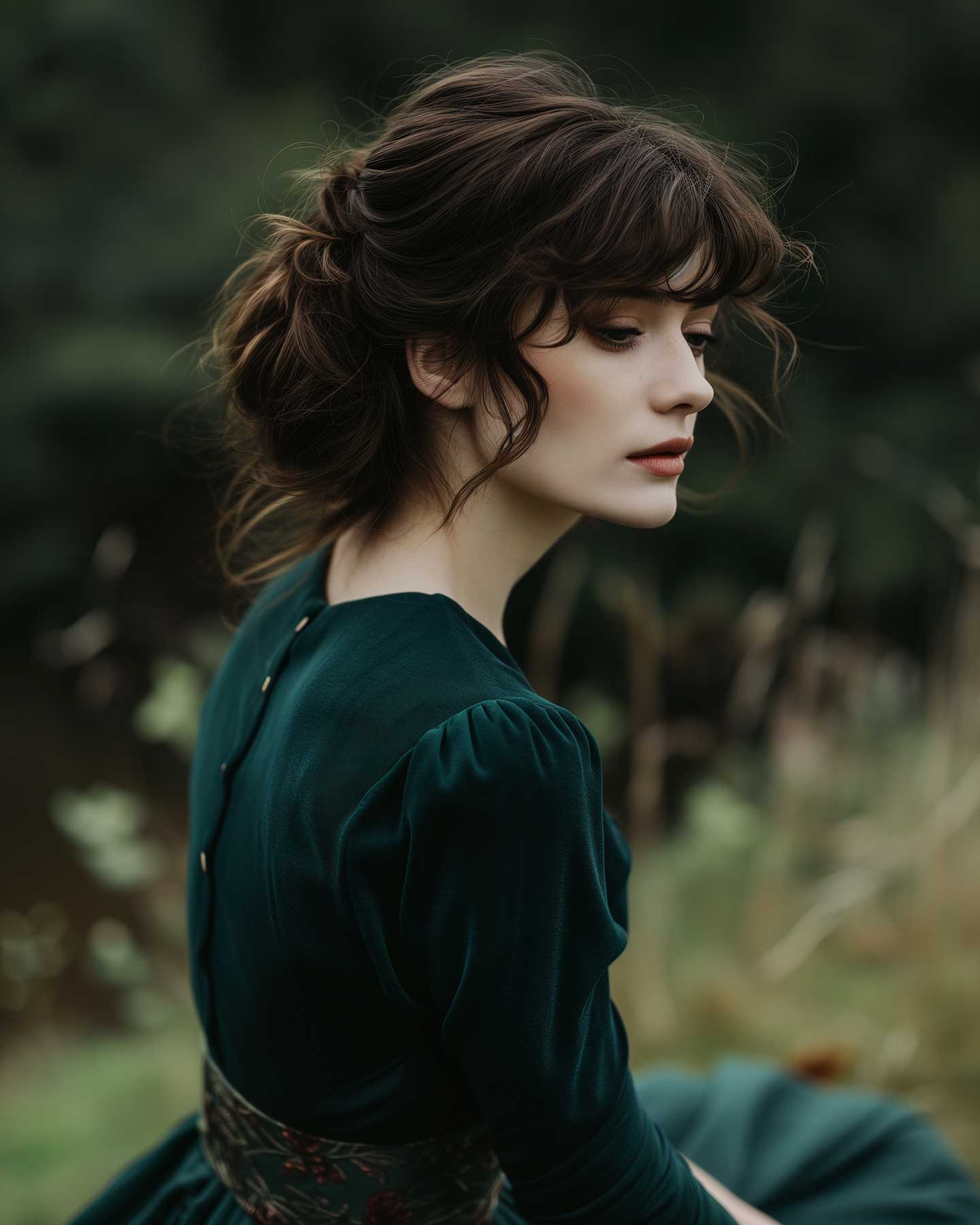
I couldn’t resist pulling this gorgeous lesson from Renee Mueller into focus for our monthly lesson. It’s wonderfully moody and yet approachable and it ties into the emotion and literary influences of Romanticism. Enjoy!
You can also listen to this month’s issue of the Studioworks journal. I find I love listening to books, podcasts and music while I draw, paint or go on a long walk. Enjoy.
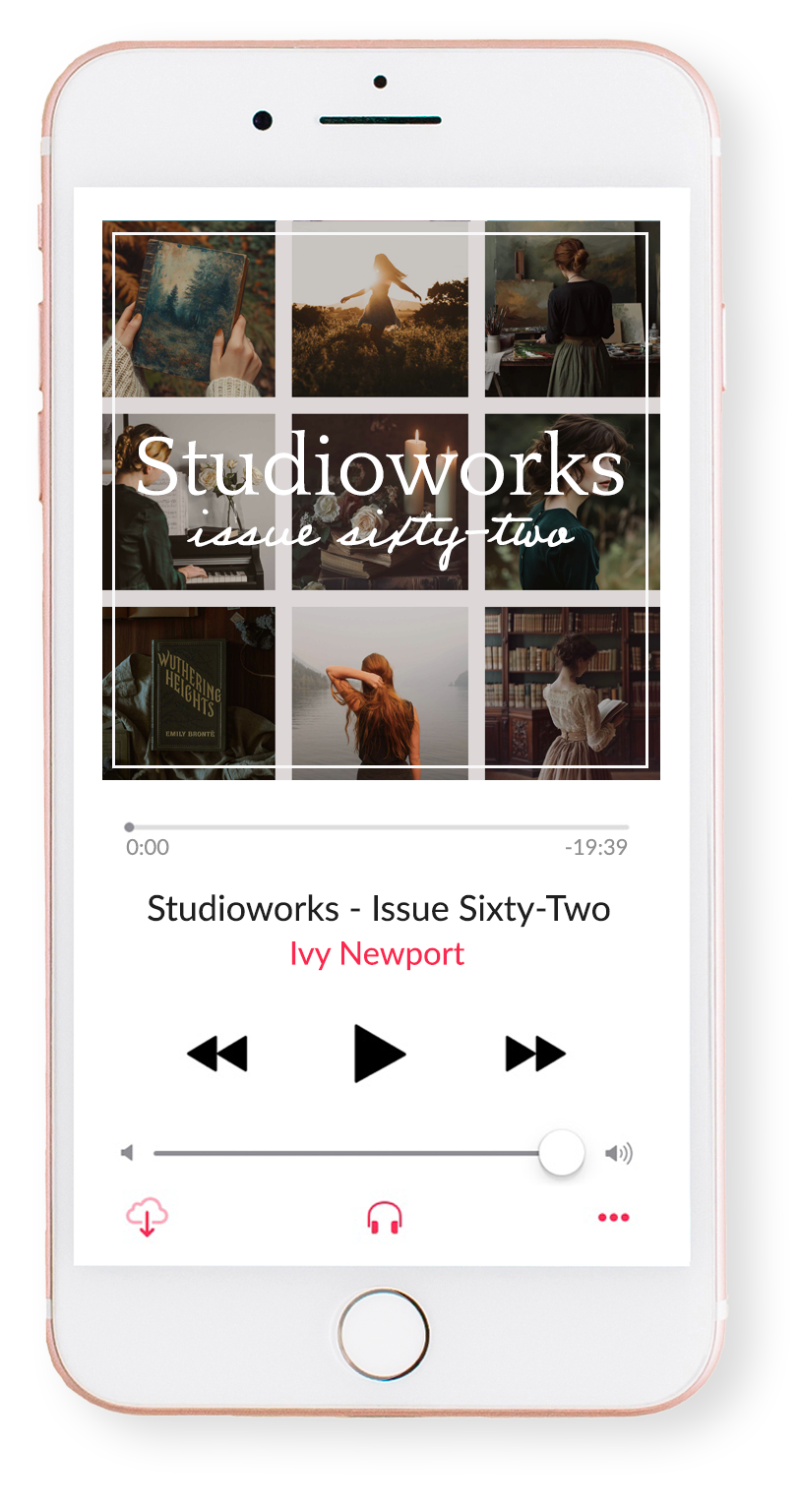

One of my favorite things to do is to curate inspiration. From Pinterest boards to books, resources, playlists and more - I love to share anything that might facilitate learning, expansion, and sparks of curiosity! Being an artist, we naturally crave these things so here are some of this month’s picks from me to you.
I had so much fun curating this list. I hope you enjoy!!
Here are just a few of our fantastic classes! I highly recommend checking them out if you haven’t already. Enjoy!